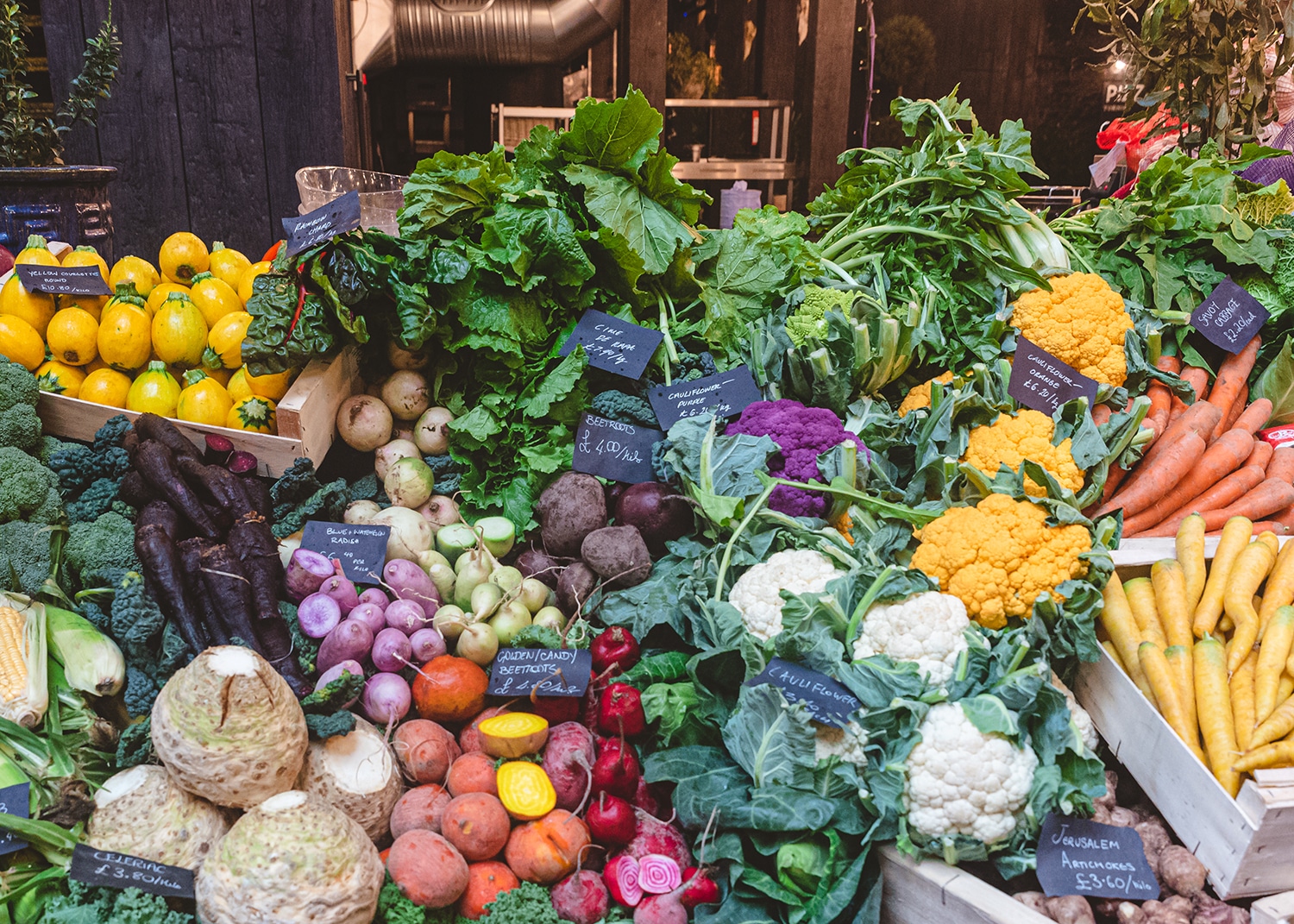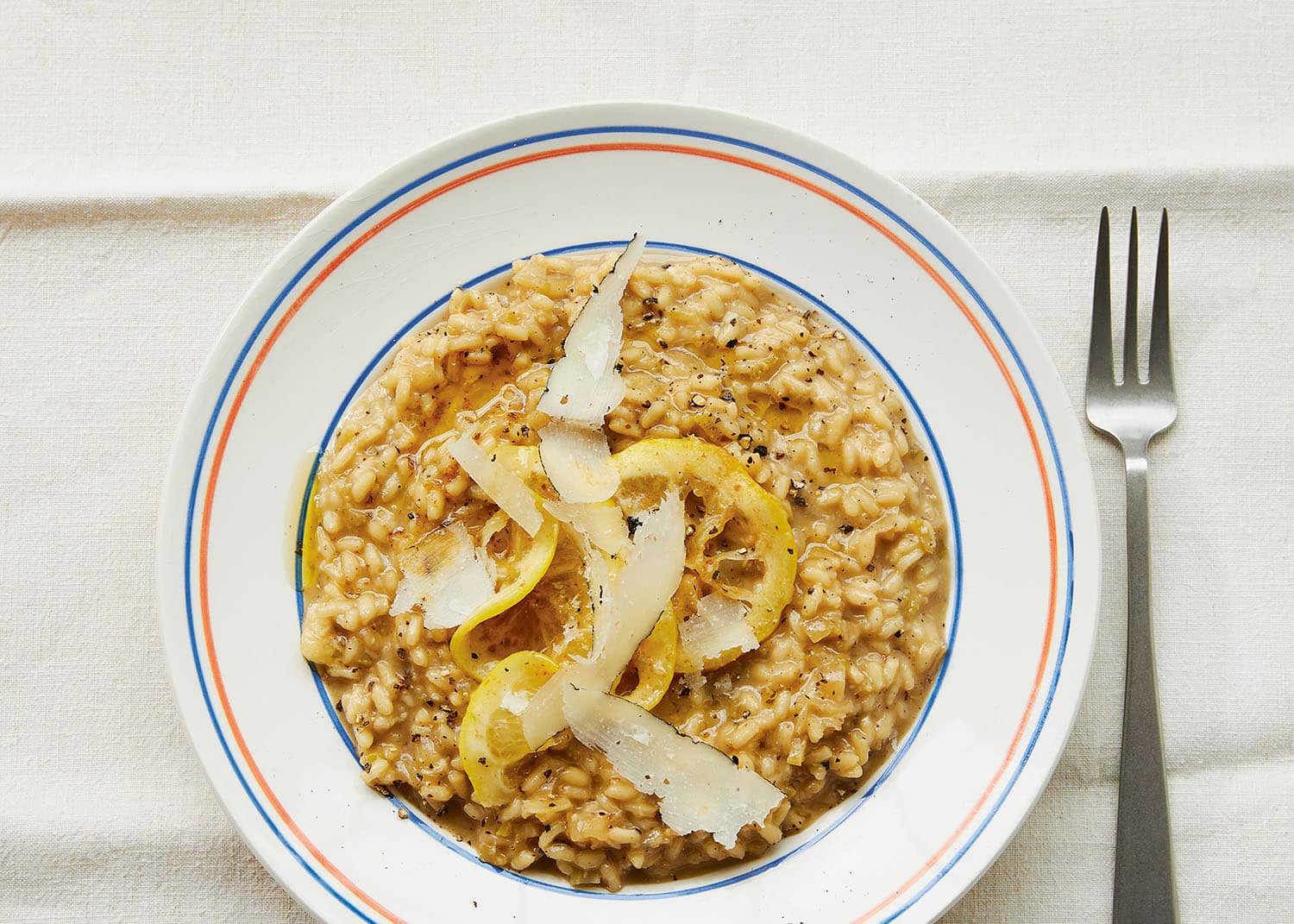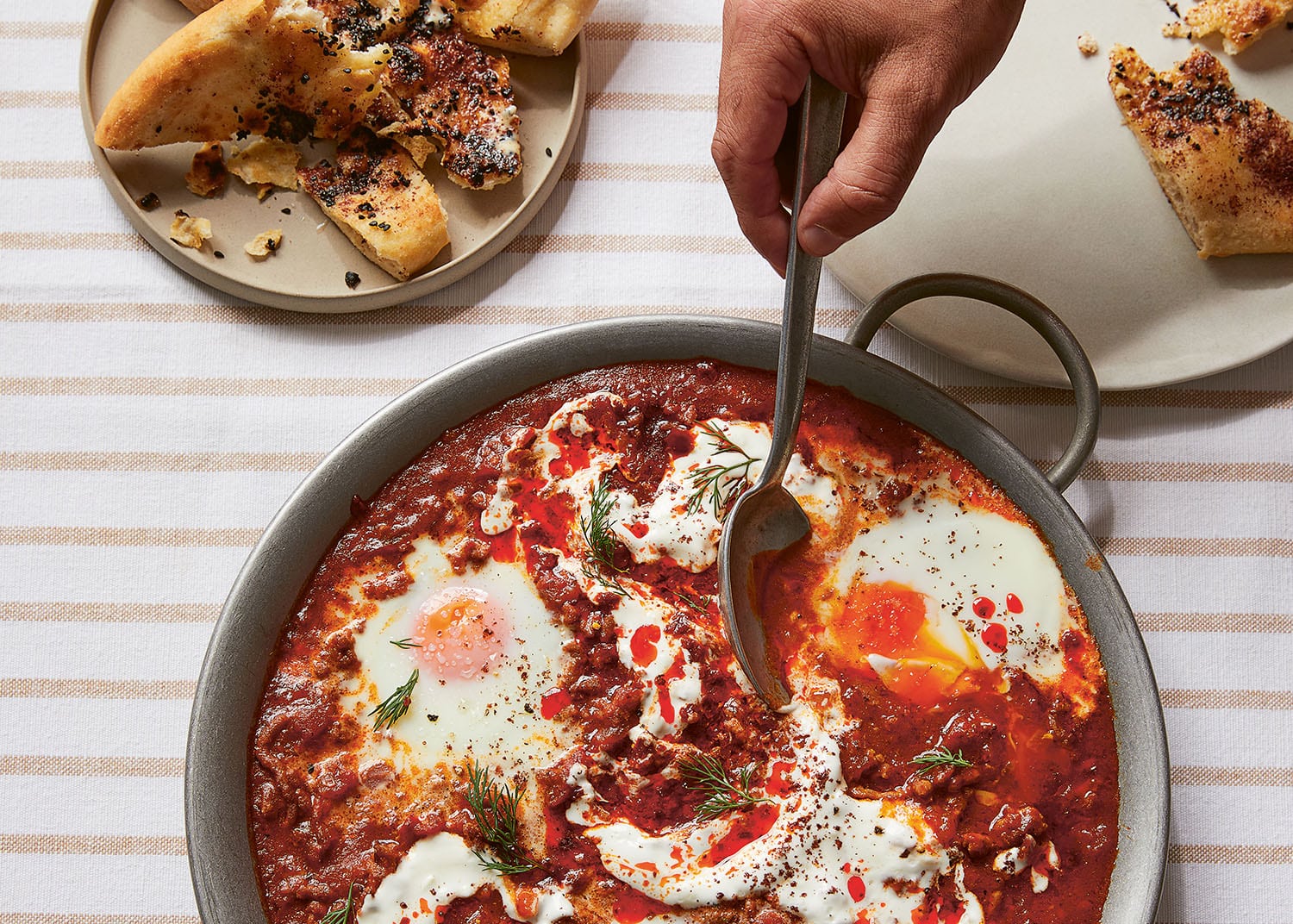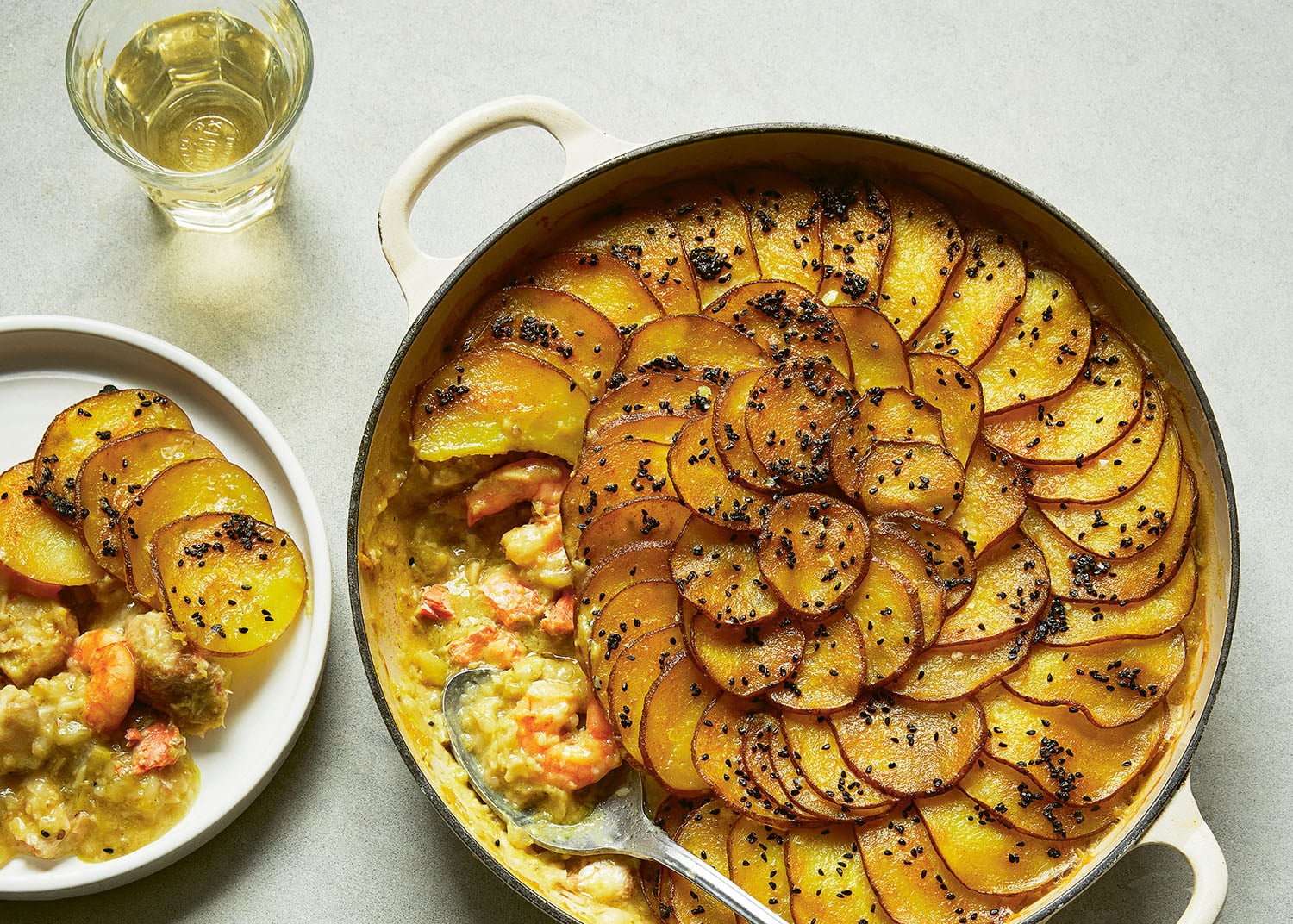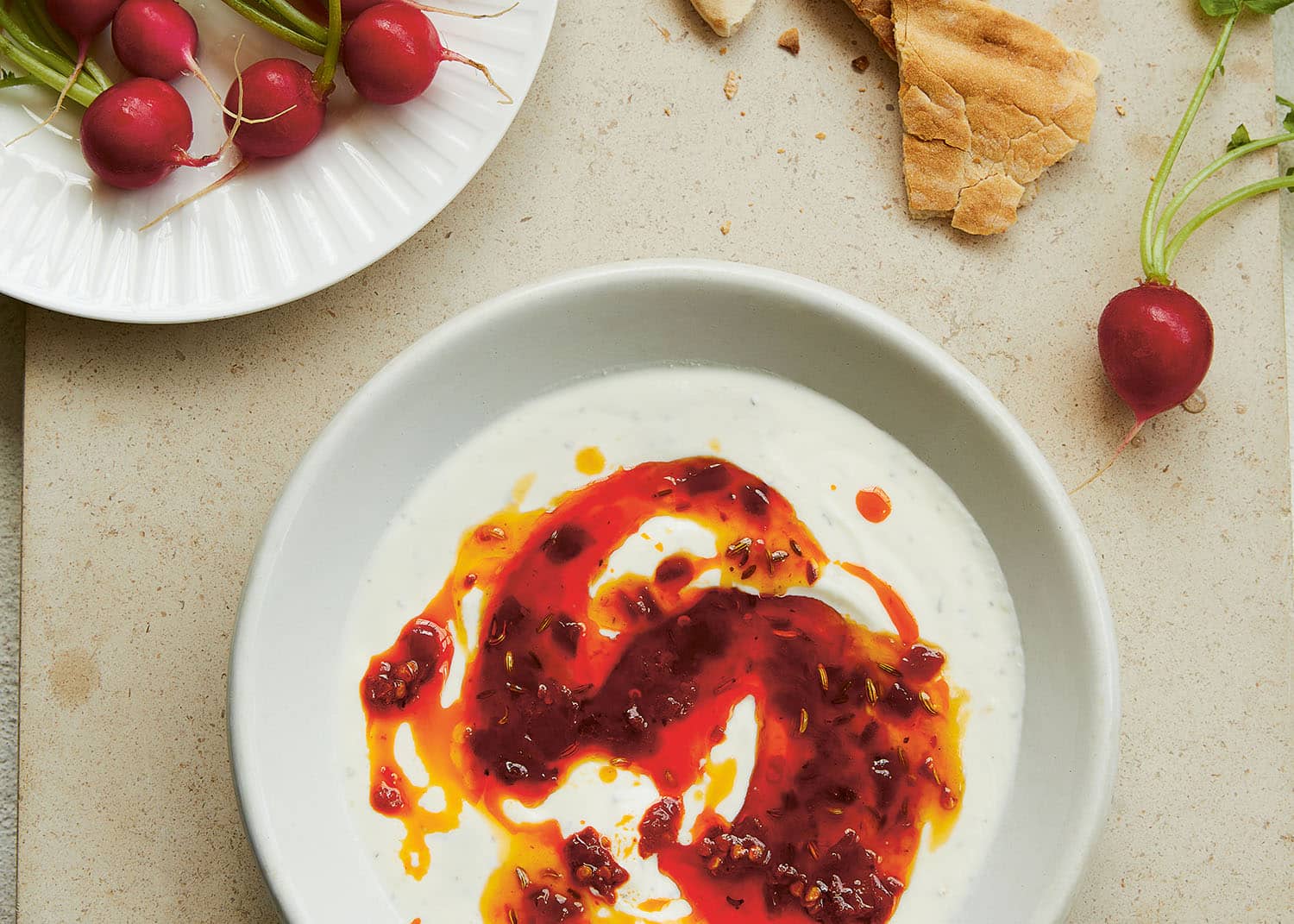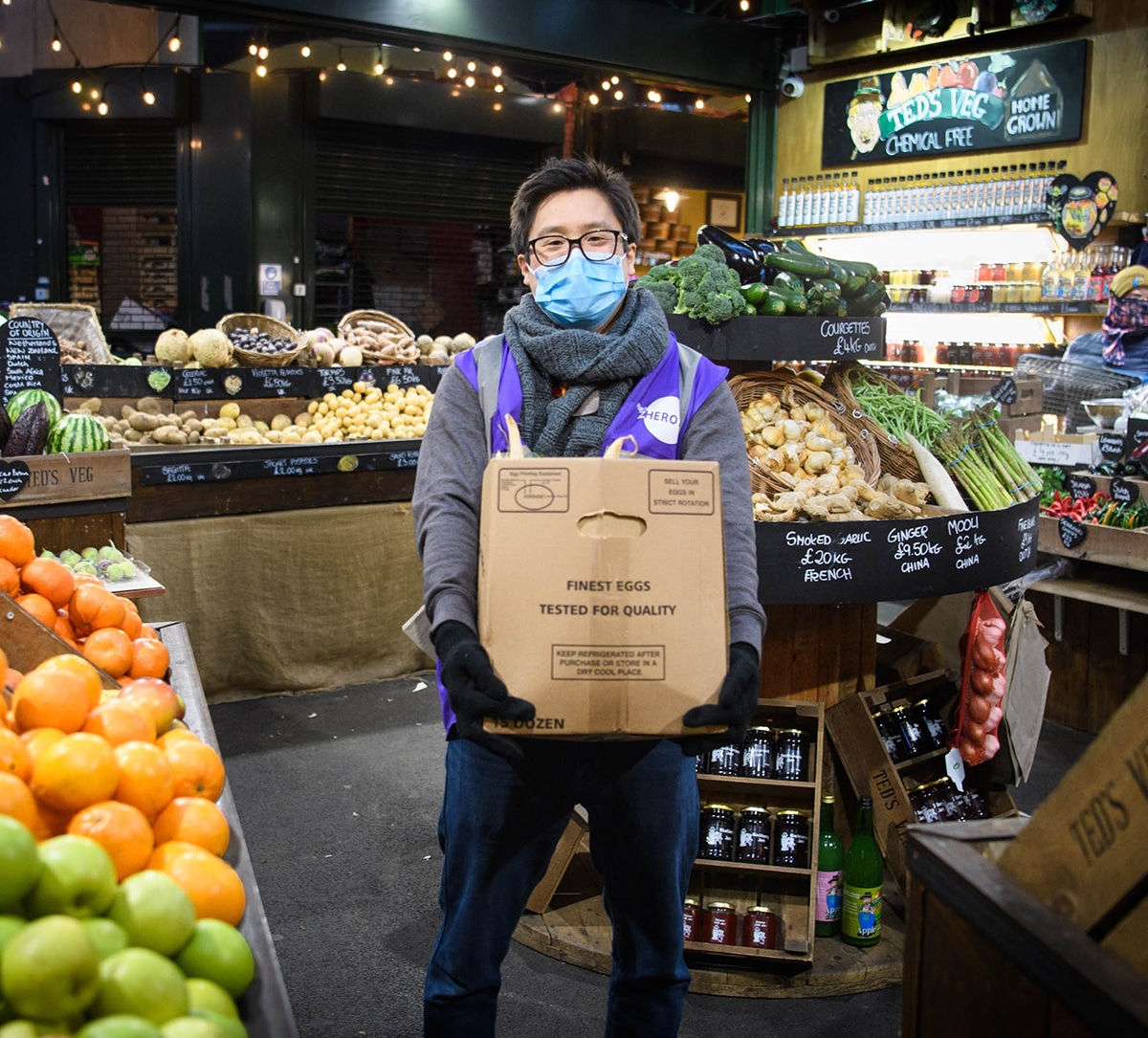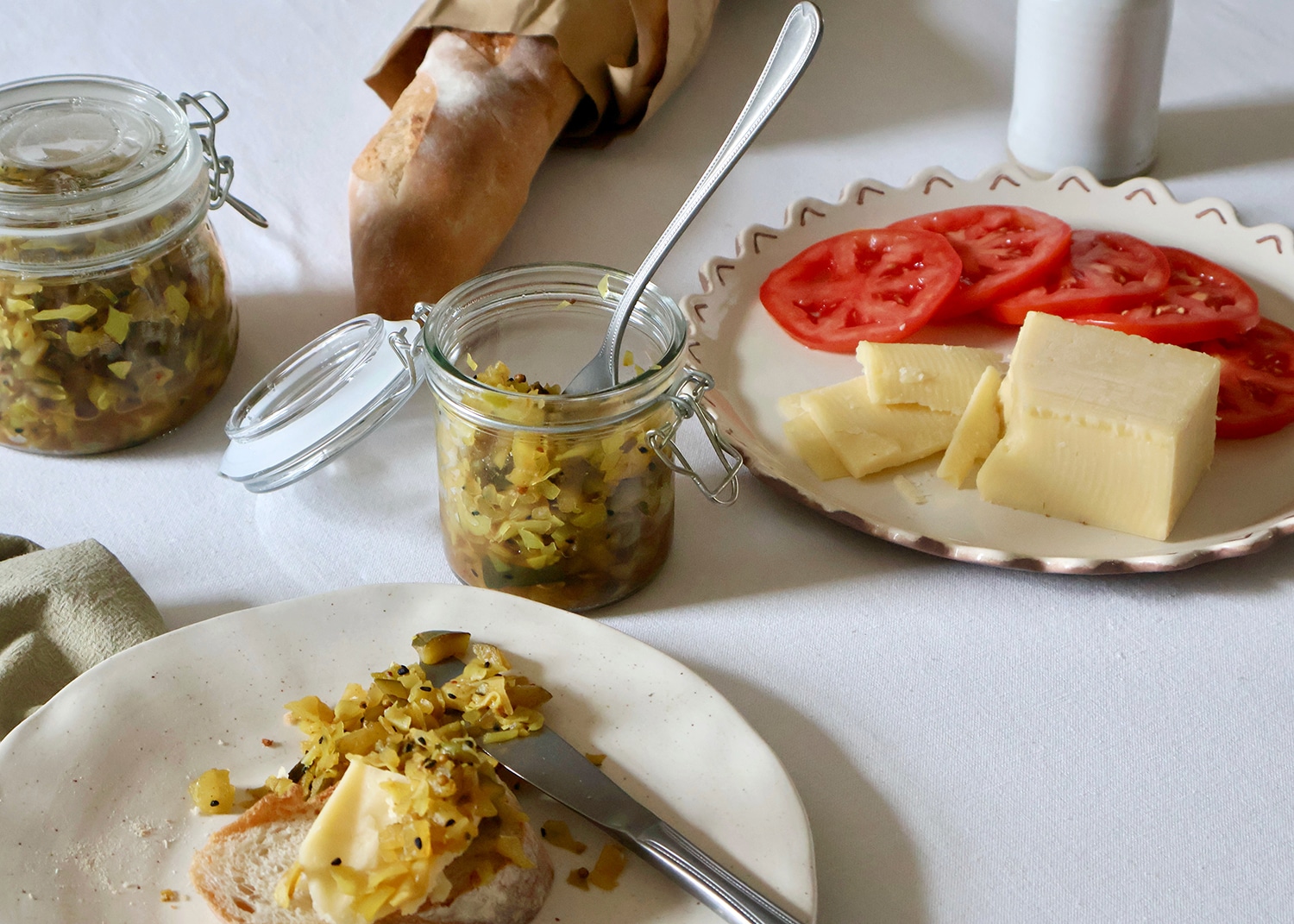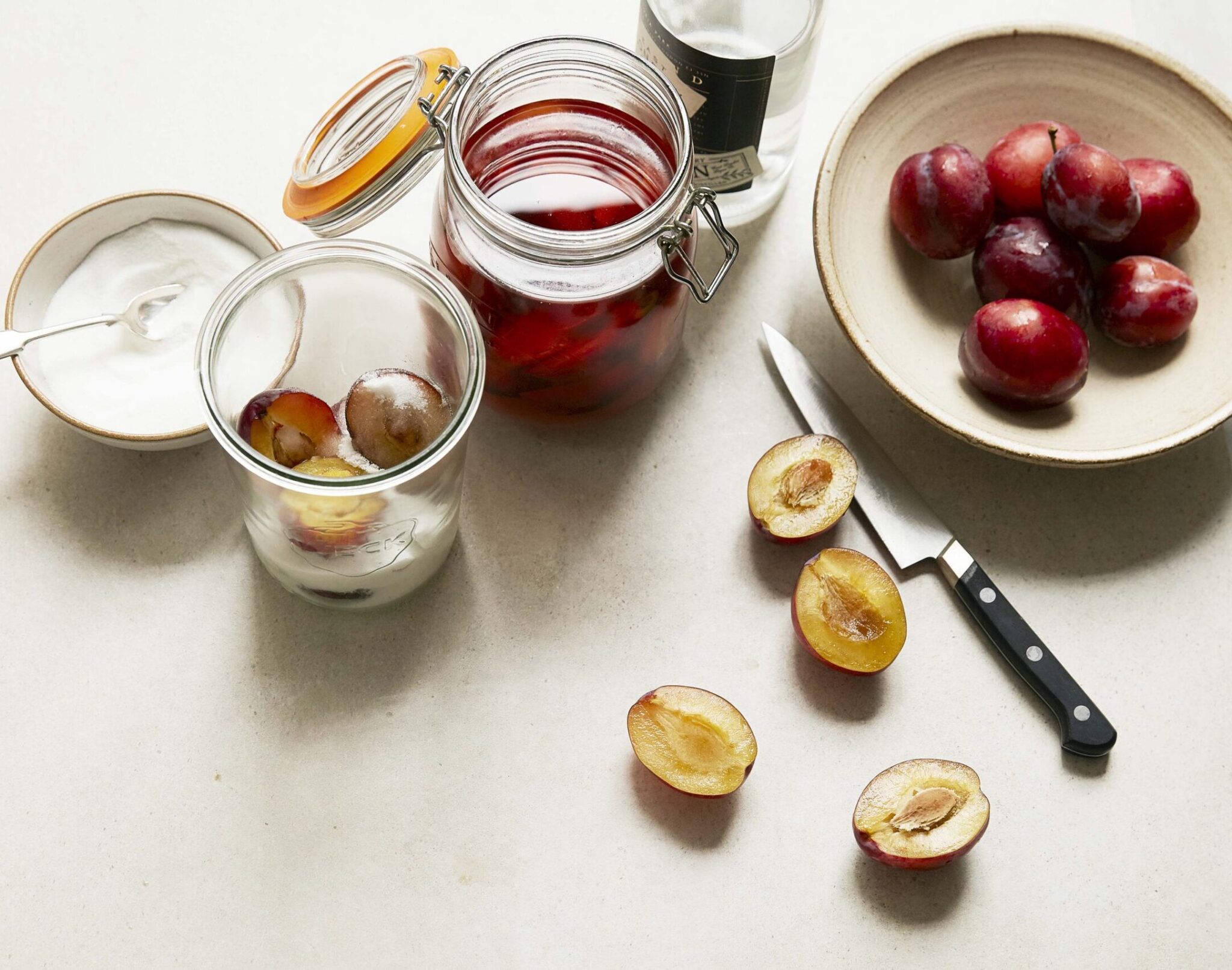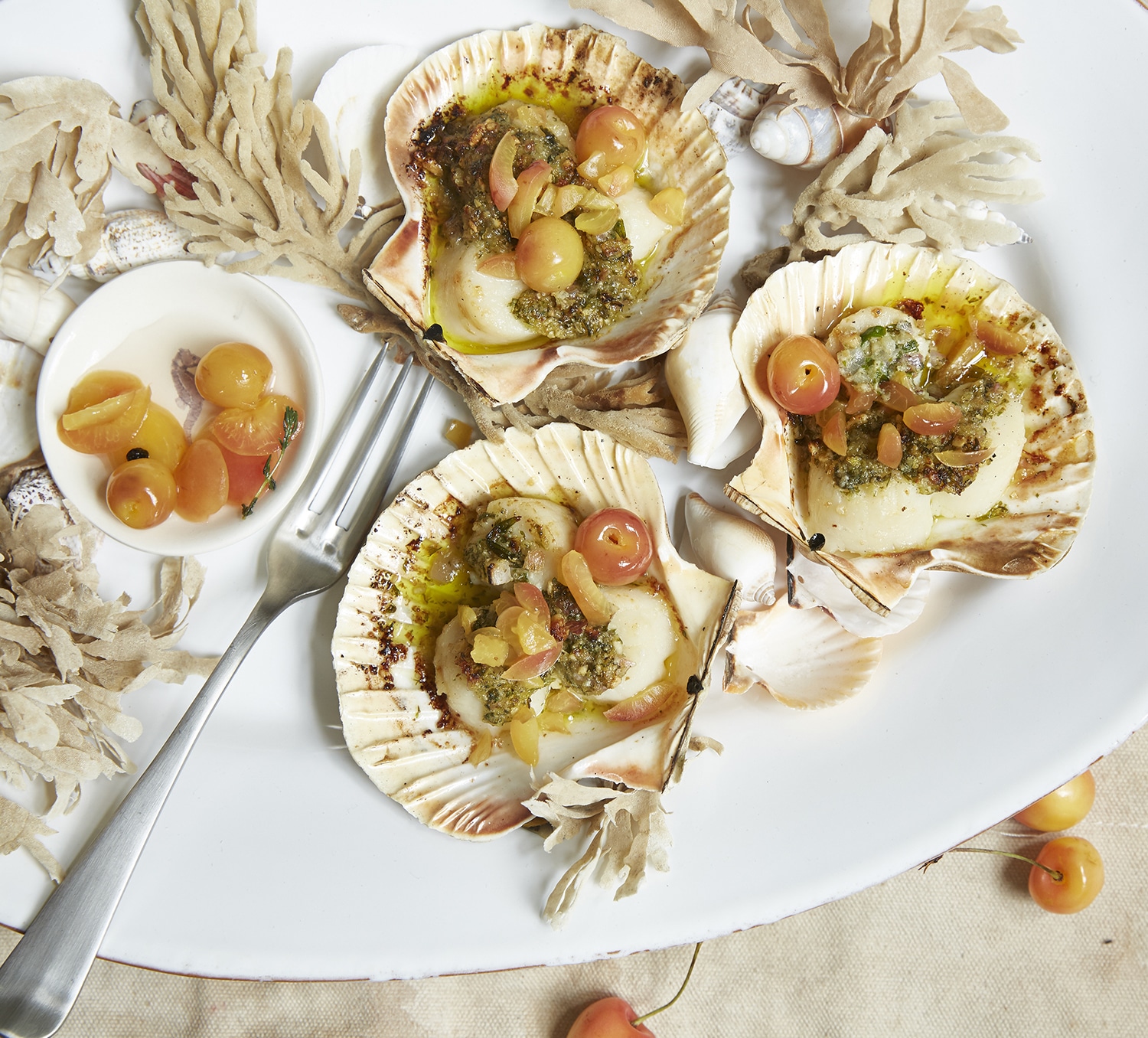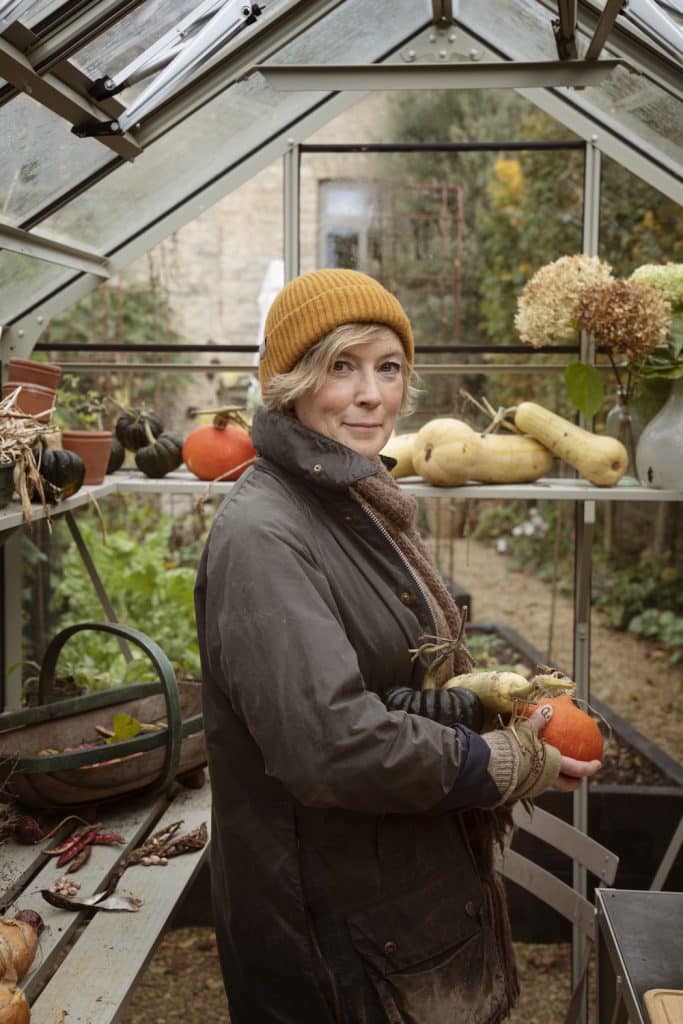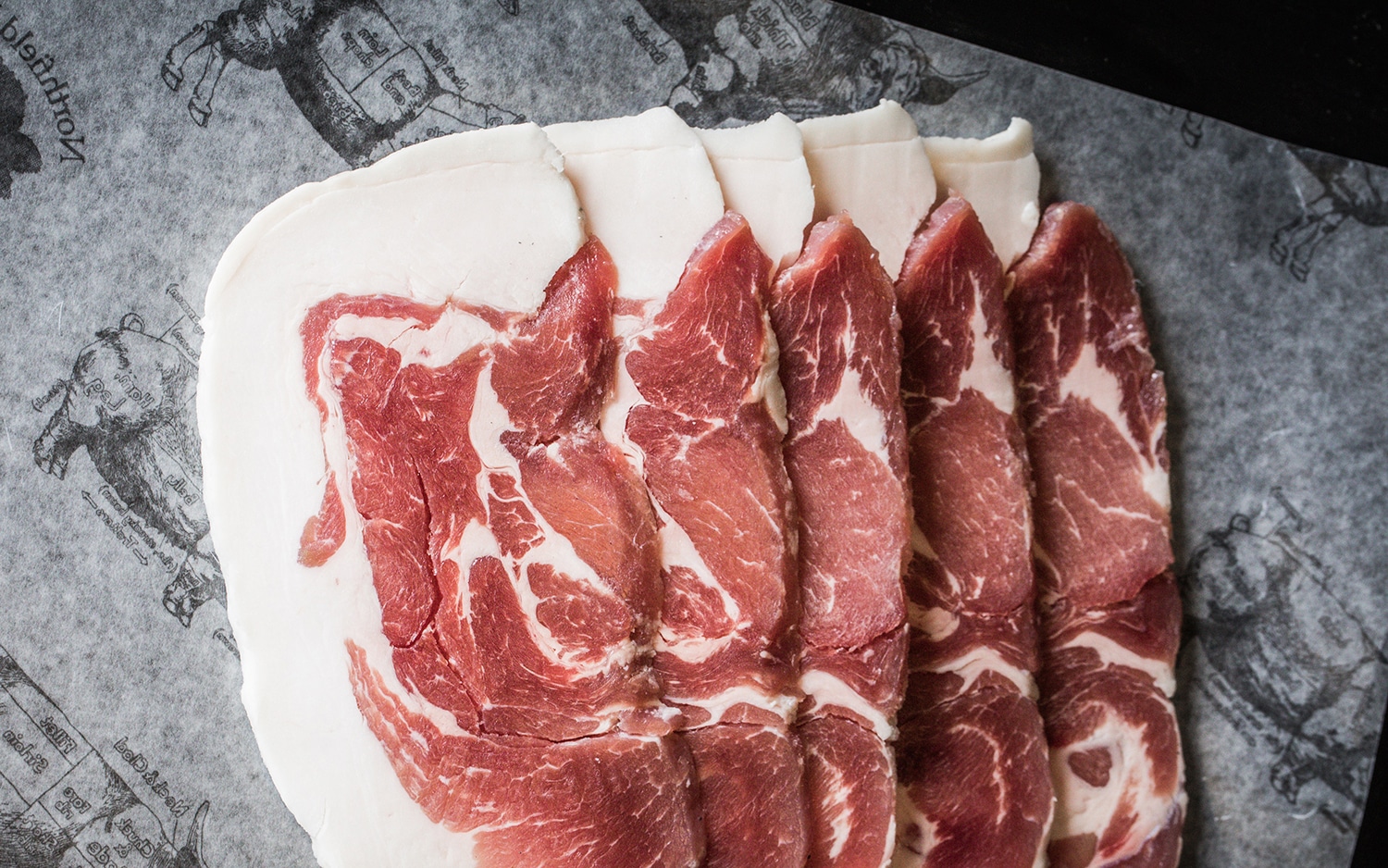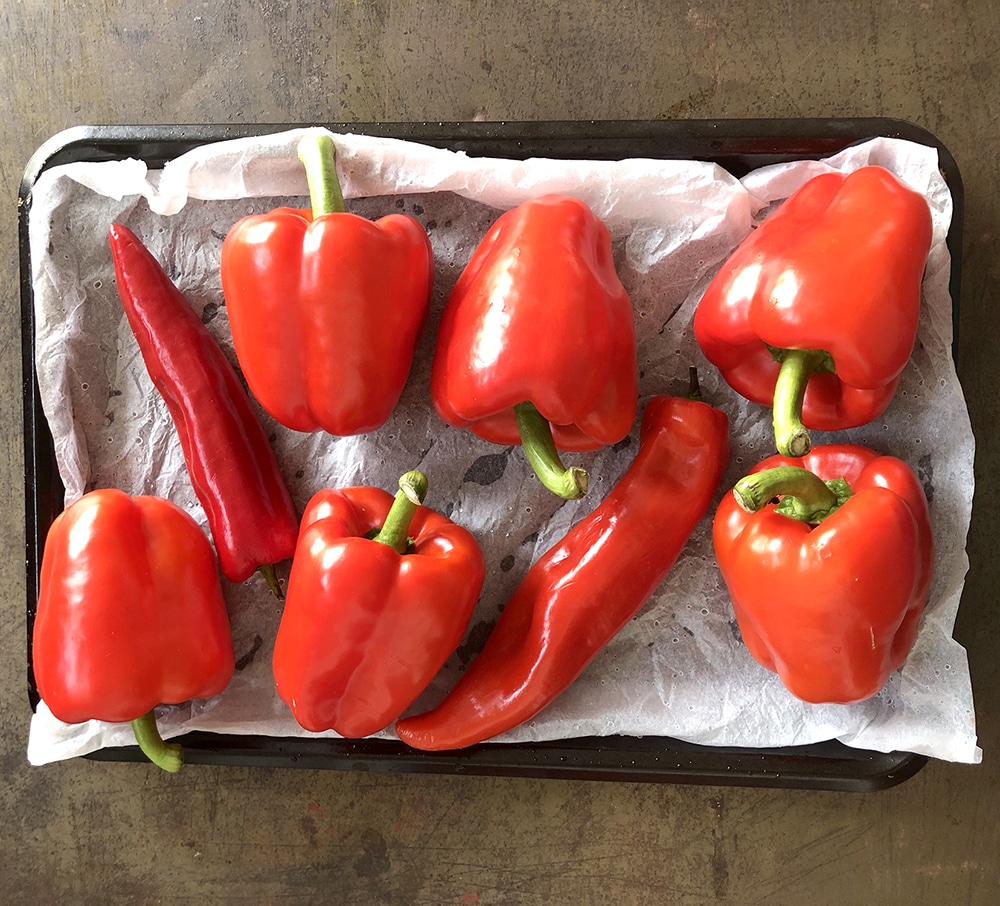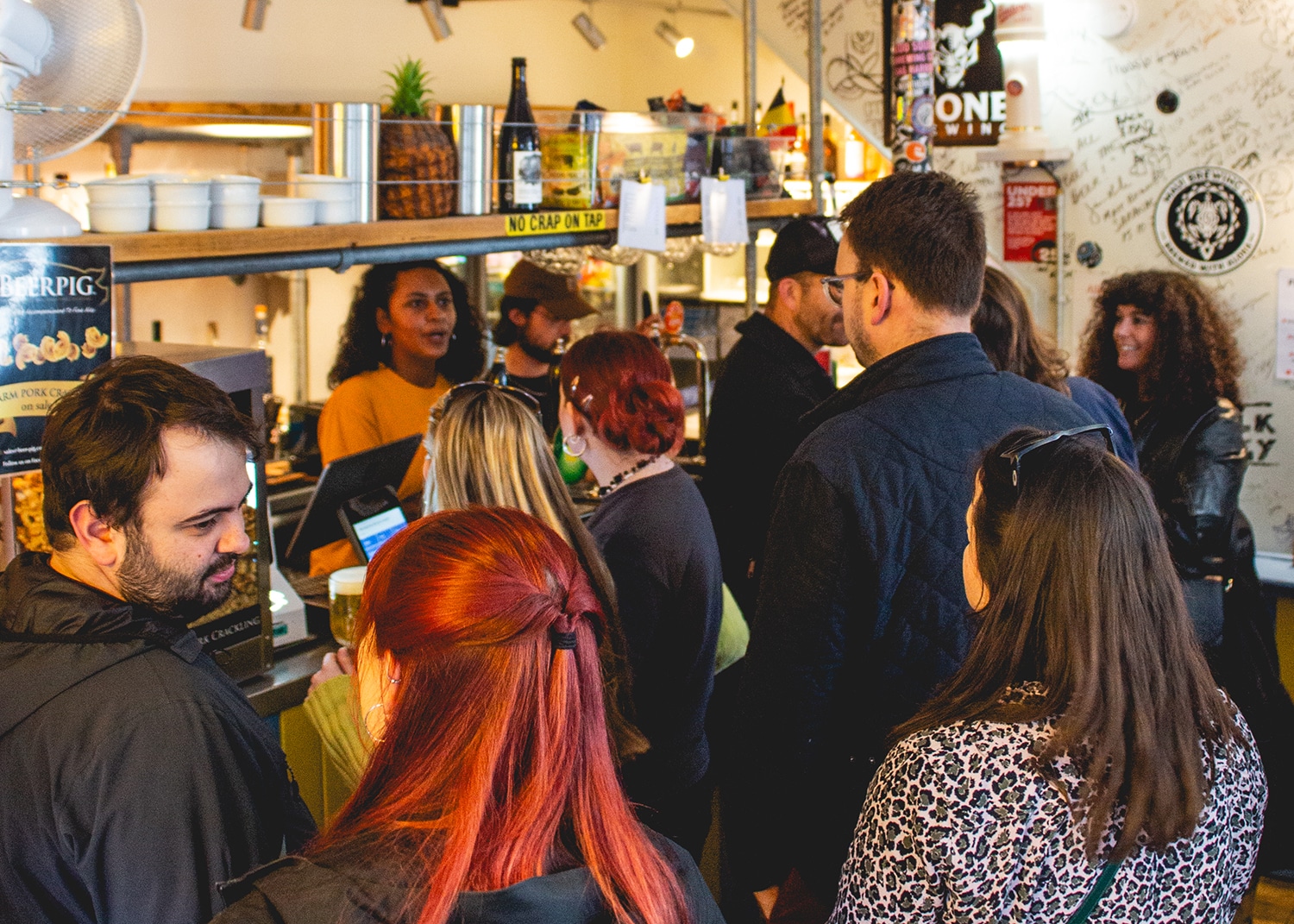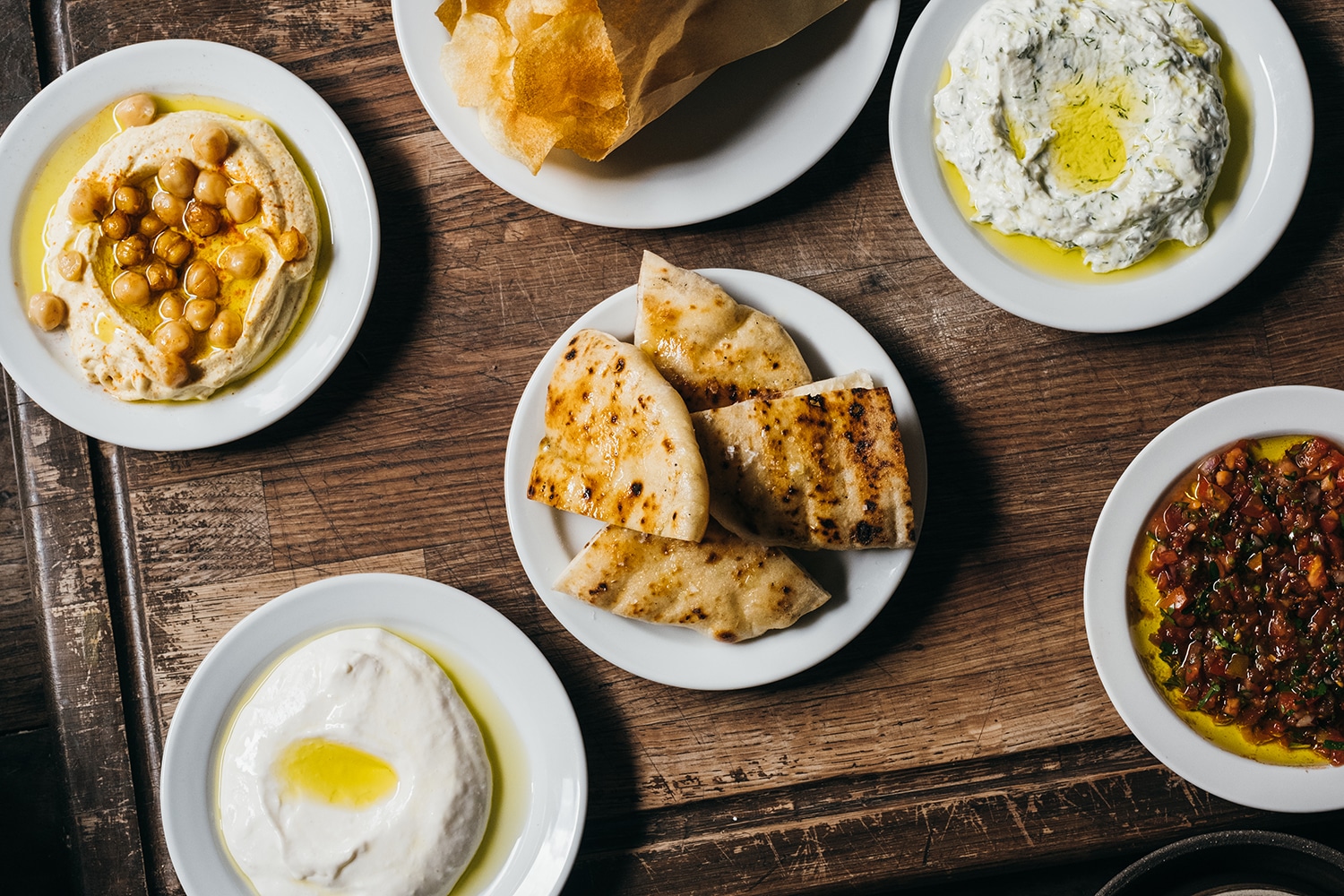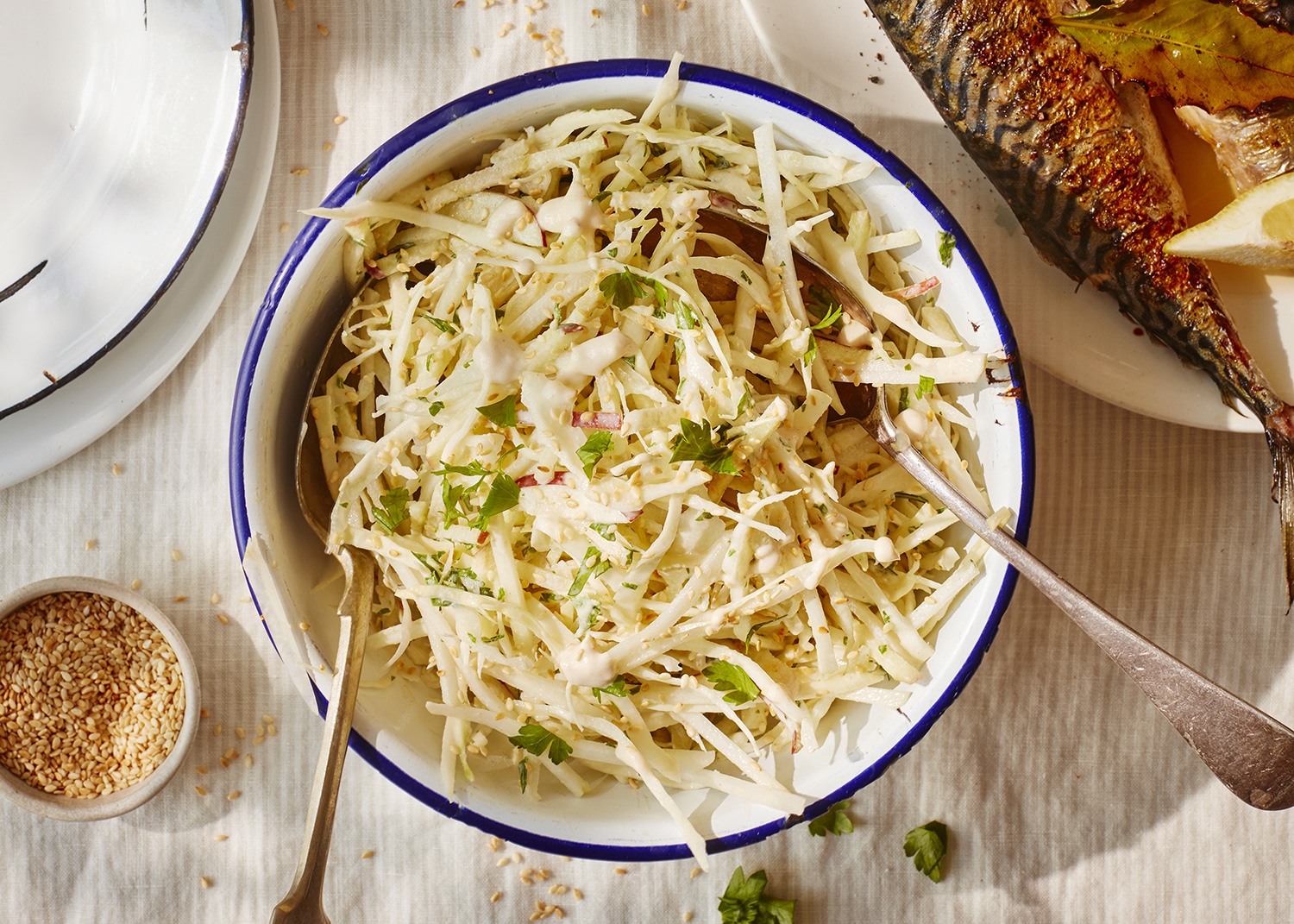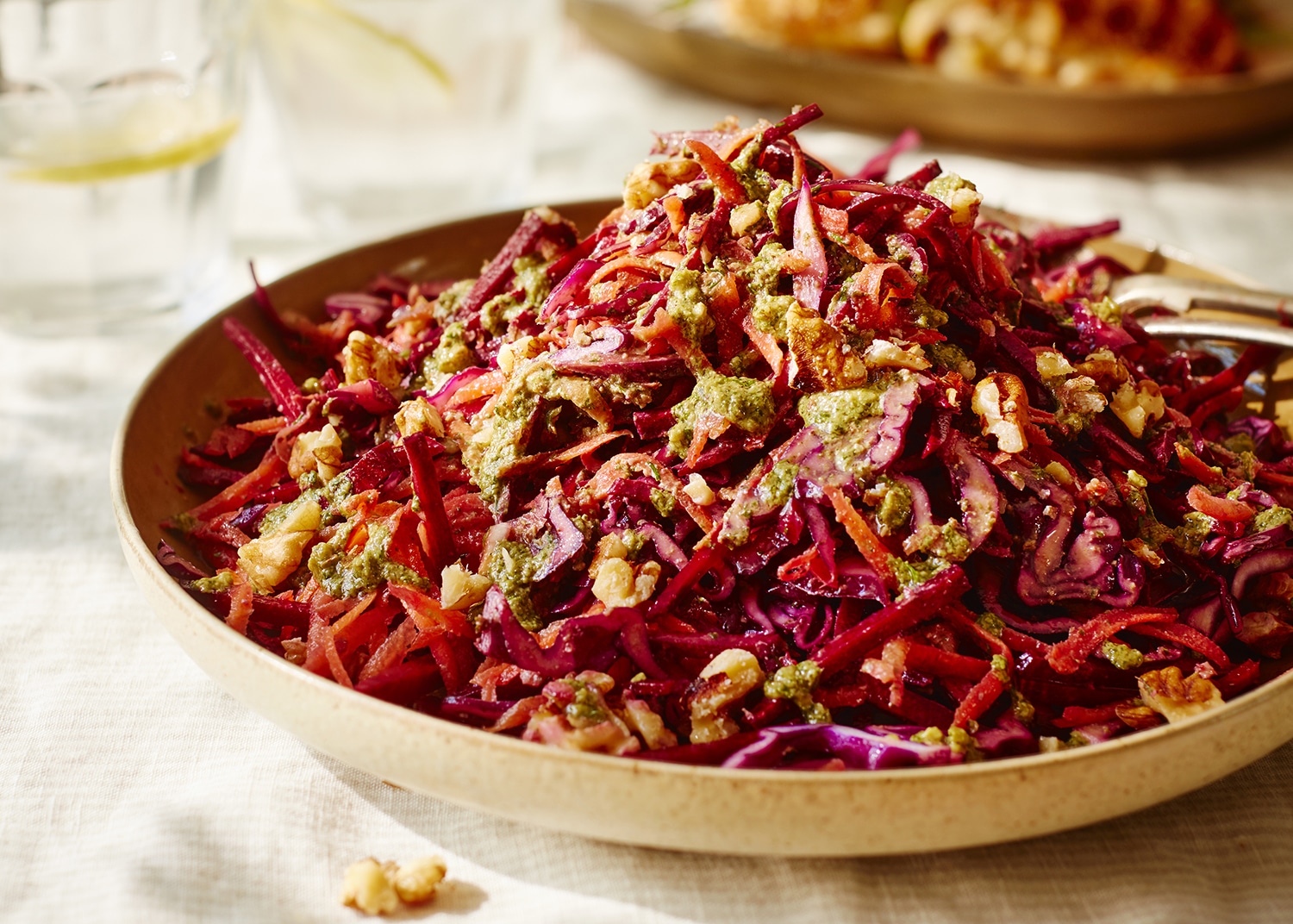Food for thought: markets vs supermarkets
Professional chef Camille Aubert answers our question: what can markets offer that supermarkets can’t?
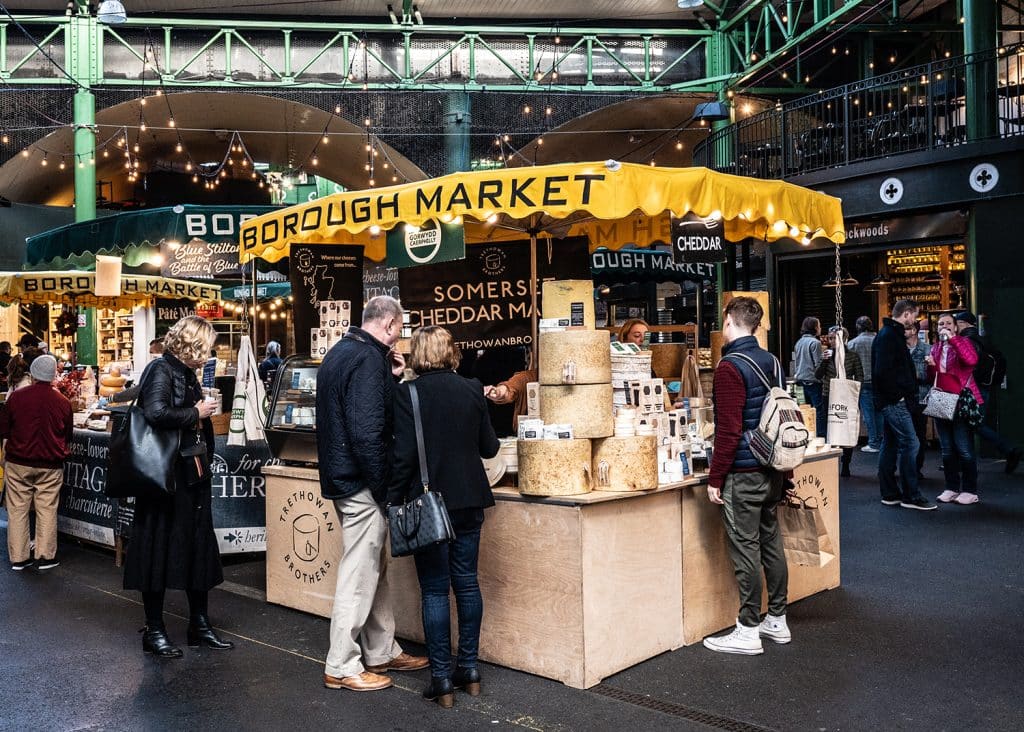

“CONVENIENCE ISN’T EVERYTHING. AS WELL AS GREAT FOOD, WHAT YOU CAN FIND IN A MARKET IS HUMAN CONNECTION”
Portrait: Orlando Gili
Borough Market, which is run by a charitable trust, exists “for community, the love of food and a better tomorrow”. This statement informs everything from our Food Policy to our work with local schools; it also sparks lots of questions about what we do and why we do it. This autumn, we’re throwing some of those same questions out to experts beyond the Borough Market community.
This week’s answer comes from Camille Aubert of Call Her Chef. A highly talented private chef and recipe developer based in south London, Camille has for several years been making Borough Market her main port of call when buying ingredients to cook for her clients.
Question: What can markets offer that supermarkets can’t?
When I was growing up in Provence in the south of France, going to food markets was such a normal thing to do. For almost everyone there it’s just part of the routine. We have supermarkets too, of course, and they’re great for store cupboard ingredients, but the farmers’ market is where we go for produce. Across the different towns in your area there will be a farmers’ markets almost every day of the week, and you can buy all the fresh food you need. Provence is a region with so many beautiful local ingredients, and we make the most of what we grow.
What I found in London was very different. When I first moved here 15 years ago, I was surprised by how important the supermarkets were and how late they closed. Back home in Provence, the shops still close early. Here, there are supermarkets open until 1am. It says a lot about life in London – everyone in this city is so busy, and we expect everything to be open and accessible at all times of day and night.
At first, I thought it was great. Back then, I was working as a restaurant chef, starting early and finishing late, and I would go shopping at midnight on my way home from work. When I left France, people told me: “You’re going to really suffer with the food in England.” But I never suffered. I could find everything I needed whenever I needed it. Because of that, it took me a while to realise how much I missed going to the market. When I discovered Borough Market, I started coming here all the time.
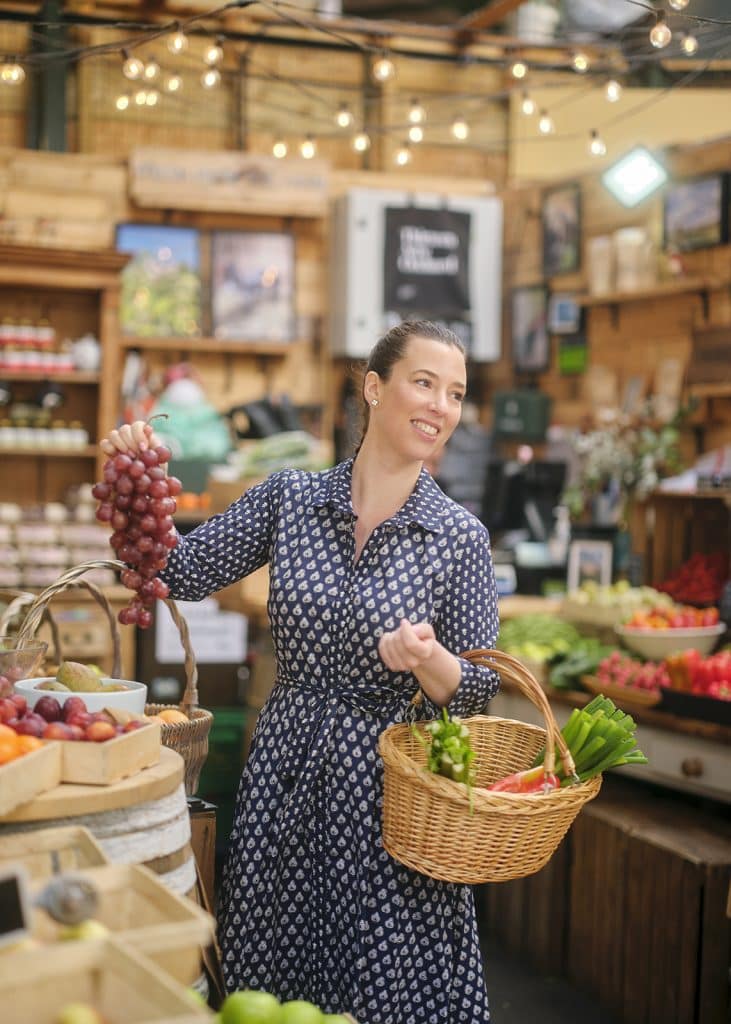
Convenience is important, of course, but it isn’t everything. As well as food, what you find in a market is human connection. The experience at a supermarket is quick and cold – these days, you can shop without speaking to anyone at all; headphones in and just crack on. The market is different. In a busy week, I might go to Borough four times to pick up ingredients to cook for my clients, and the hour I spend there talking to the traders, these smiley people who are so passionate about what they do, it really makes my day. We’re social animals, and those moments of contact are so important, but you have to seek them out. The world we live in today simply isn’t made for it.
Conversations with traders have a social benefit, but they also help me professionally. When I’m cooking for a client, I always go to the market with a provisional meal plan. If the traders have the ingredients I want, I know they’ll be the best quality. If they don’t have something, it’s because it’s not in season or not at its best that day. But there’s no panic. I just talk to the people on the stalls. They’ll tell me: “Try this instead. It’s similar, these are the flavours, this is how you cook it.” Even though I’m an experienced chef, their knowledge of the produce means I can still come away with new ideas and inspiration. They have so much to share.
The sensory experience of the market is another part of its appeal. There’s a saying among chefs: “The eyes eat first.” First, it’s the appearance, then the smell, and only then does the sense of taste become important. If all those things are right, you have a great dish. It’s the same at a market, where inspiration comes from every sense being stimulated. The traders put their love into displaying the food, so when you arrive at Borough, everything looks so beautiful and smells so good. It’s a feast for the eyes and the nose.
And then you get to taste. If you’re in a supermarket, you never get to try the produce. At the market, if you want to buy some cheddar, for example, but you don’t know which of the many varieties to go for, the traders are happy to guide you and will often give you a taste. Recently, I was offered a spontaneous demonstration of different olive oils. I wasn’t planning on it, but the trader was so keen and lovely (“You should try this one, try that one, try this one too…”) so I started my day with several shots of olive oil. The one I left with was exactly what I needed.
Another great benefit is that you often buy exactly as much as you want. When you go to a supermarket, sausages only come in packs of six or eight. At Borough Market, you can say: “I just want two breakfast sausages and four rashers of bacon,” and they’ll give you two sausages and four rashers of bacon. You can get what you need, avoid unnecessary waste and also eat better food.
I know that for someone who has never shopped for produce at a market before, Borough may be a bit overwhelming at first. It’s big and it’s busy and you might actually have to speak to people! My advice? Start simple. It’s not about buying the craziest or most expensive of ingredients. Make a short list of familiar things, or the ingredients for a favourite dish; even if it’s just bread, salmon and carrots, the quality will be so high. Go with your list, walk around and don’t be scared to ask questions. Go a couple of times, get used to your surroundings, and, like me, you’ll soon have your own little routines – just like you do in the aisles of the supermarket, but in a far more beautiful environment. The more you talk to the traders, the easier it will get, and the more open you will be to trying new things.
It’s true that you can’t go shopping at Borough Market at midnight. But that doesn’t make me love it any less.
Hero worship
Gurdeep Loyal on his ‘flavour heroes’: the store cupboard staples he relies on to add an instant punch of flavour to his cooking
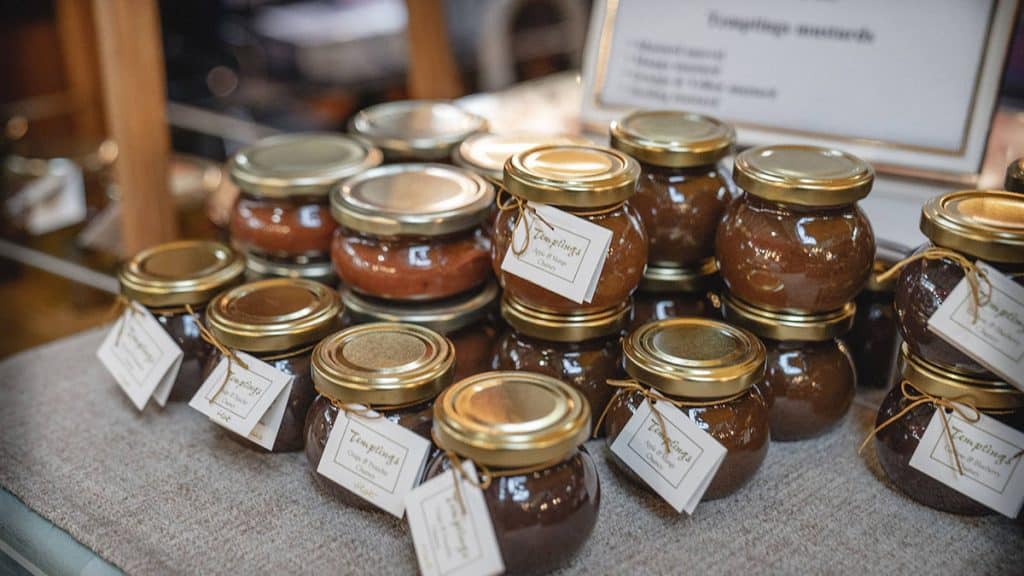

“I WANT INGREDIENTS THAT CAN BE MIXED COMPLETELY DELICIOUSLY WITH OTHER FLAVOURS FROM AROUND THE WORLD”
Words: Gurdeep Loyal
The spark that ignited my latest cookbook, Flavour Heroes, came from a particularly nosy friend. Browsing through the abundantly filled shelves of my east London kitchen, she was quick to highlight that while they appeared to be filled with hundreds of different jars, bottles, tubs and tubes from around the world, many of these were in fact variants of the exact same things. And she was completely right: I had five different peanut butters, six tamarinds, five types of miso and over 10 varieties of mango chutney. This extended to my fridge, which contained three types of nduja – one in a glass jar, a thick slabbed slice, and a big bulbous sausage!
These ingredients are what I call ‘flavour heroes’ – taste-amplifying powerhouses that can turn up the volume of your home cooking every day of the week, no matter what you’re making. In my book, I spotlight 15 of the store cupboard staples that I turn to again and again, as freely as a painter might reach for colours in a palette or a composer to instruments in an orchestra.
Borough Market has been a constant source of inspiration for these daily cooking heroes and has cemented a few within my regularly replenished pantry repertoire. One such is Calabrian chilli paste, also known as crema di pepperoncini, a bright crimson paste made with red diavoletti rossi chillies, olive oil and salt. The jars sold at De Calabria have an intensely volcanic heat I find addictive. In the book I use it to make a Calabrian chilli-honey butter for drizzling over whipped feta, and in a slow-cooked short-rib ragu with broken lasagne.
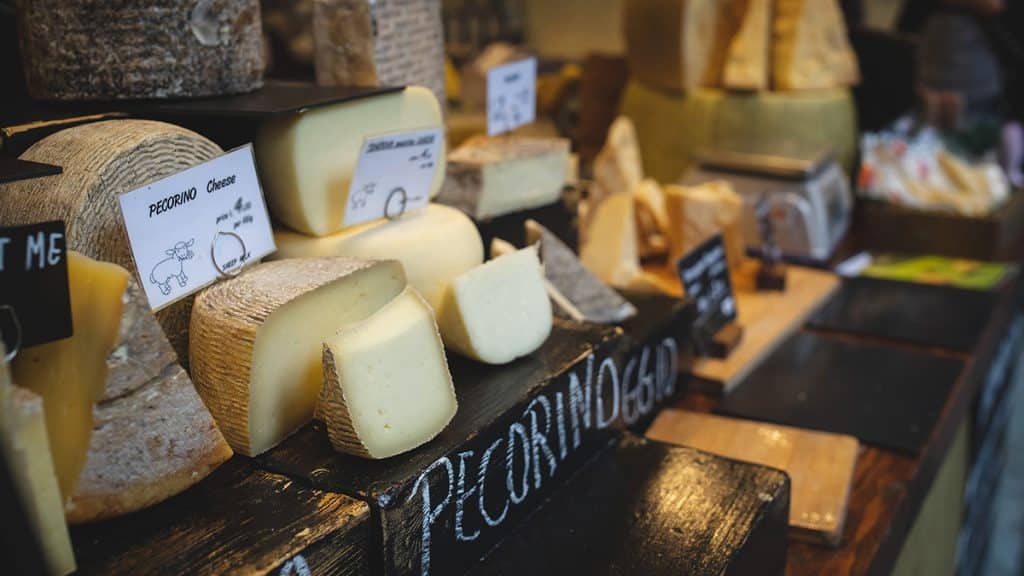
Another hero of mine is pecorino Romano, a sharp tangy sheep’s milk cheese I use even more often than parmesan. It has a wonderful grassy brightness and nutty graininess. Many of the cheese traders at Borough sell pecorinos, some infused with black pepper and truffle, and L’Ubriaco Drunk Cheese even has a Sardinian pecorino that’s been aged for 10 months in red wine. I transform pecorino into a moreish cacio e pepe risotto and even use it in the crust of a savoury-sweet Italian apple crostata.
The very first hero in the book is harissa – a heady red paste rich in hot chillies, garlic, coriander, caraway and cumin, which I pick up fresh from Borough Olives. The aforementioned mango chutney is another ingredient for which Borough Market provides me with a cornucopia of options – the Punjabi-spiced jars from Temptings (pictured top), or the small-batch handmade Caribbean jars from Pimento Hill, which combine chunky fresh mango with hints of scotch bonnet pepper. I use mango chutney as the glaze for a root vegetable tart tatin with roasted garlic and also transform it into a marinade for crunchy breadcrumb-coated chicken schnitzels.
Raya is another stand I can spend hours browsing, and their Thai pastes, tamarind, miso, gochujang and toasted sesame oil, all of which feature in my book, are weekly staples for me, and ingredients that I have multiples of on my shelves.
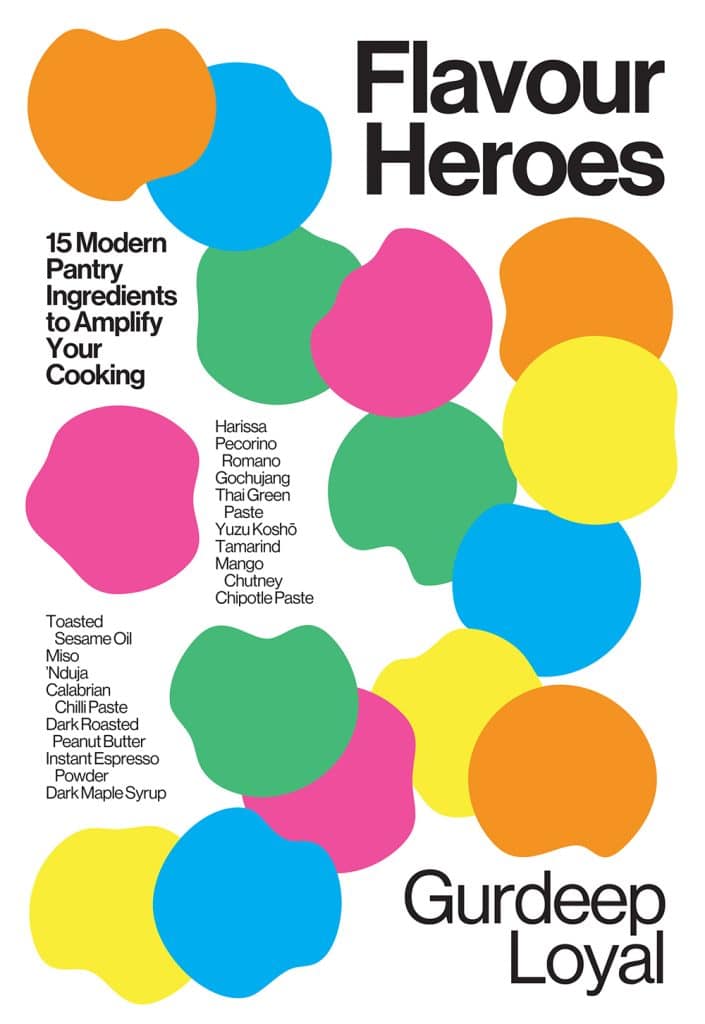
This global hotchpotch of ingredients reflects my relationship with food right now. I want to be able to cook big bold flavours with little effort, every day. I also want ingredients that allow me to be playful at the twist of a lid and can be mixed completely deliciously with other flavours from around the world – nduja with gruyère, miso with cornichons, sesame oil with blueberry pancakes, harissa with manchego. To me these intercultural flavour combinations reflect the connected food world of today – and the adventurous palates of this most global of cities.
Flavour Heroes by Gurdeep Loyal (Quadrille Publishing) is available now
Golden hour
How the continental ritual of aperitivo, with its drinks, snacks and conversation, provides a welcome moment of pause and connection
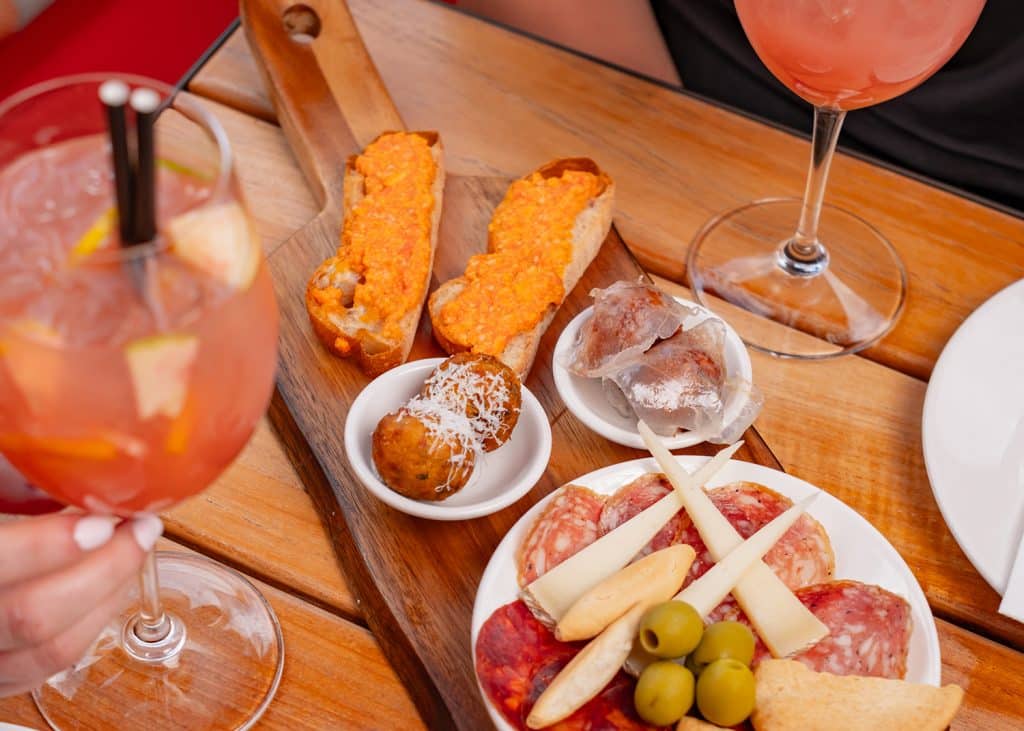

“APERITIVO PROVIDES A MOMENT TO PAUSE, CONNECT AND RELAX, BATHED IN THE SOFT GLOW OF EARLY EVENING SUNLIGHT”
Words: Giulia Crouch
Is there anything better than a drink and a little snack with friends before dinner?
A golden hour ritual that awakens the appetite, offers a chance to unwind, and builds excitement for the meal to come. This is aperitivo – the beloved continental tradition of pairing a pre-dinner drink with a selection of perfectly formed bites. Typically enjoyed between 6 and 8pm, it’s a moment to pause, connect and relax – ideally at a charming bar in a piazza, bathed in the soft glow of early evening sunlight.
Here in the UK, we’ve slowly come to embrace the charm of this pre-dinner ritual. After all, if anything can elevate an after-work tipple, it’s a salty olive or a slice of prosciutto. And there are few better places to enjoy both of those than Borough Market – whether you’re settling in for a drink and a bite or picking up beautiful ingredients to recreate the experience at home.

“Aperitivo, or aperitif, is to me a very continental – even Mediterranean – phenomenon,” says Monika Linton, founder of Spanish food company and London tapas institution Brindisa. “It centres around a number of key elements: weather, people, food and drink. Most towns, villages and cities have beautiful central squares where people of all ages meet up – often daily – for a walk, a chat, a drink and a snack. Borough Market is such a perfect space for this kind of gathering, not unlike a square in a Spanish city. What is also incredible about Borough is that you can take a walk to the river and back, in a similar way to how Spanish folk promenade as part of the evening experience – taking in the joys of the city and the river.”
The roots of the aperitivo stretch back to ancient times. The idea of a drink to stimulate the appetite or aid digestion dates to the classical era. The Romans drank vinum absinthiatum (wine infused with wormwood) for its digestive benefits, and the Greek physician Hippocrates recommended bitter herbal infusions to support digestion. The aperitivo’s core idea is bound up with its name, which comes from the Latin ‘aperire’, meaning ‘to open’.
The modern aperitivo, as both a drink and a cultural ritual, began to find form in 1786, when Antonio Benedetto Carpano, a distiller in Turin, created vermouth – wine fortified with a blend of herbs and spices. Around this time, the term aperitivo began appearing in advertisements and product labels. From there came the rise of iconic Italian aperitivo brands: Campari (founded in Milan in 1860), Martini & Rossi (Turin, 1863), and Aperol (Padua, 1919). These bitters and vermouths were poured in cafes and bars across northern Italy, sold as a way of opening the palate before dinner. In cities like Milan and Turin, the aperitivo hour became a stylish and sociable ritual – drinks accompanied by small, salty snacks like olives, nuts or slices of salumi.
Nowadays in Italy and Spain, bars get competitive with their aperitivo offering, each hoping to outdo each other with ever more elaborate and delicious snacks. “People are fully aware of the specialities that each bar offers and they may go to a few in one evening – best croquetas in one place, best wines, best anchovies in another, best ham in another,” says Monika.
Though, as Gisela Garcia Escuela from Borough’s Gastronomica Italian deli warns, you need to be careful not to spoil your appetite. “Aperitivo shouldn’t be heavy – you don’t want lots of bread that’s going to fill you up. Instead, I’d recommend anything in oil: olives, artichokes, mushrooms. In Spain we have a pickle with a bit of cheese on a toothpick, but you could also have cheese, sundried tomato and an olive. You can have anything you like really. There are no rules. I’d just avoid very filling food, unless that’s what you’re going for.”
In recent times, though, the aperitivo has in some places evolved into the “apericena” – a blend of aperitivo and cena (dinner). Bars began offering buffets or substantial platters for the price of a drink, blurring the lines between drinks and dinner and providing a budget-friendly way for young professionals and students to enjoy a night out. But if you’re sticking to the original spirit of aperitivo – that is, opening the appetite – what’s the best way to do it? Which food and drink pairings truly hit the mark?

“At Brindisa, we’ve always brought in ingredients that are perfect for this moment: manchego cheese, hams, anchovies, sardines, pickles, piquillo peppers, olives,” says Monika. Her go-to pairings? “Beer with salted Marcona almonds, red vermouth with olives or gildas, Iberico ham with champagne, and aged white wine with cured sheep’s cheese.”
Ewa Weremij from Italian food importers Bianca Mora prefers to keep things classic. “I like salami sliced by hand, some chunks of parmigiano Reggiano, a few olives and a glass of wine. You could also add fruit – I really love cheese with strawberries.”
For Gisela, it all comes down to the drink’s flavour profile. “I’d go for something classic like vermouth or Campari – the bitterness gets your taste buds going and makes you hungry. Some people prefer white wine or prosecco, but I think that bitterness is key.”
I have to agree. My ideal combination is a Campari and soda, served with chunks of aged parmigiano dotted with balsamico tradizionale, or little slices of bread topped with a slice of cold butter and a salty anchovy. That, to me, is aperitivo heaven. But really, it can be whatever you want it to be: Italian, Spanish, French, Japanese, Mexican, the list is endless. The formula is simple: gather your friends, pour some drinks, and lay out some excellent snacks.
As Monika puts it: “It’s an incredibly happy way to meet with family, different generations, friends – and a great way to make more friends!”
We’ll raise a glass to that.
Among the cheesemongers
Author and cheesemonger Michael Finnerty on friendship, pride and healthy competition within the Borough Market community


“FOR ME, BOROUGH MARKET IS THE PEOPLE – WE HELP EACH OTHER THROUGH GOOD TIMES AND BAD”
Words: Michael Finnerty
Cheesemongers at Borough Market know a lot about cheese. Above all, we know how magical and mysterious a product it is. It’s hard to predict when a batch of a given cheese – perhaps a newcomer but often an old friend – might suddenly cross the line into a realm of taste that makes you float off the ground as you eat it. Sometimes a cheese can be so popping that it blows minds, hitting so many pleasure centres all at once that you have to tell the others about it.
And when I say ‘the others’, I mean the other market traders. “Esther, you have to try this.” “What is it?” She puts it in her mouth. “Oh my god!” “Right? New wheel we just got in. Can you believe it?”
Esther will no doubt come by to purchase some later – cheese that good gets stuck in your mind – but the point of sharing it with her isn’t to boost sales. The point is that traders at Borough Market become something like a family, and we want to share these moments. I love seeing Esther smile. It’s like fuel for the rest of the shift.

When cheesemonger Karen from around the corner popped by with a Caerphilly sample, she couldn’t resist spreading the word about. Partly, it’s about our pride in our products. We work with smaller producers and it’s not an easy life for them. Using more traditional methods with smaller batches, sometimes coming from a single herd, there are loads of ups and downs. When they exceed even our high expectations, we want to share the results not only for the pleasure of tasting but also to convey our admiration for the makers.
One slower weekday mid-morning, one of my colleagues decided to undertake an impromptu blind taste test of different wheels of Comté being sold at different stalls around the market – such a great idea. There were some surprises, but it’s good for everyone to be kept on their toes. If you choose to work at Borough Market, you know the competition is stiff and you know the bar is high – and I wouldn’t have it any other way. We all want to be better, and we all want each other to be better. A rising tide floats all boats.
I am focused on selling the best French and Swiss cheeses at our Mons Cheesemongers stand, but as I’m talking to a customer, tasting cheeses and listening to what flavours they love, I get a sense of which stalls they should go to next, and I’m thrilled if I can help them make a discovery. “You have got to try Francesco’s dried strawberries across the way,” I’ll say. “They’ll make you forget it’s cloudy and raining outside.”
Often a customer will come back as they’re leaving the market to say: “You were so right about those olives! I love them. Thank you for the suggestion.” After all, the punters come for an hour or so, but we’re here year-round and we get to know a thing or two.
You probably won’t be surprised to hear that we lean on each other all the time. When something tricky happens, we take the time to listen, sometimes over a cup of tea. We’re also in for the save: “Can you believe I forgot to order bin liners? Can you spare some for us?”
Early in the morning, the shutters clatter and grind as the stands open up to the world, a bit like our heads do at that early hour. It’s a balm to see Shuk is already hard at it, checking over a crate of apples in the pre-dawn. “Morning Shuk!” “Morning Michael!” There’s a comforting pattern to the greetings; we look forward to those brief visits before we all throw ourselves into the day.
When the market shifts into closing gear, there is a determined but happy buzz in the air. I love this time of day not just because our work is about to end but also because it’s an awesome process, a herculean heave-ho that leaves the market like a blank canvas, ready for tomorrow’s new dawn. As the last of us departs, the market settles into calm, shifting to night mode, sparkling in a different way like the London gem it is. If you’ve never wandered through with friends after dark, or hand in hand with someone you love, you’re missing out.

We know we work in an exceptional place. It inspired me to leave my former job as a journalist and don the monger’s apron. I’m about to launch a book about my apprenticeship working here and how it has changed my life. What I want you to know is that, above all, we’re a community. For me, Borough Market is the people. We help each other through good times and bad. We lift each other up and we push each other to be better. You won’t be surprised to hear we often share a pint after work, but even I was surprised by the traders’ Christmas party, where we raised the roof together right in the centre of the market. Sometimes I have to pinch myself to believe I work here.
The Cheese Cure: How Comte and Camembert Fed My Soul by Michael Finnerty (Mudlark) is available now
Land of plenty
Kathy Slack on why seasonal produce gluts are so exciting and the preservation techniques we can use to prolong them
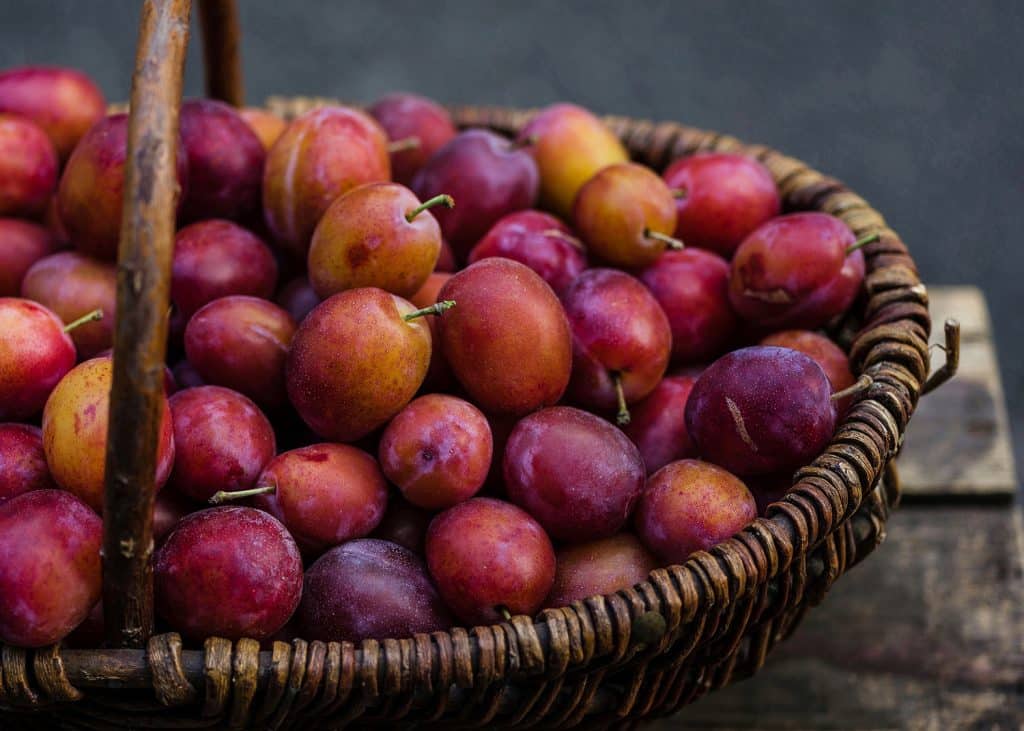

“THIS, FOR ME, IS THE TIME TO GATHER GREAT BUCKETSFUL OF PRODUCE TO PRESERVE AND STORE FOR LEANER TIMES”
Words: Kathy Slack / Images: Orlando Gili, Regula Ysewijn
I’ll be honest, I’m a terrible vegetable grower. Dreadful. I’m ramshackle and disorganised and so overexcited that I sow far too many seeds all at once or forgetfully sow the same crop twice. Either way, I always end up with gluts. Take beetroot, for example. A sensible grower would sow a few seeds in April, a few more in June, and so on until August, thereby enjoying a steady but not overwhelming supply of delicious, exciting beetroot meals.
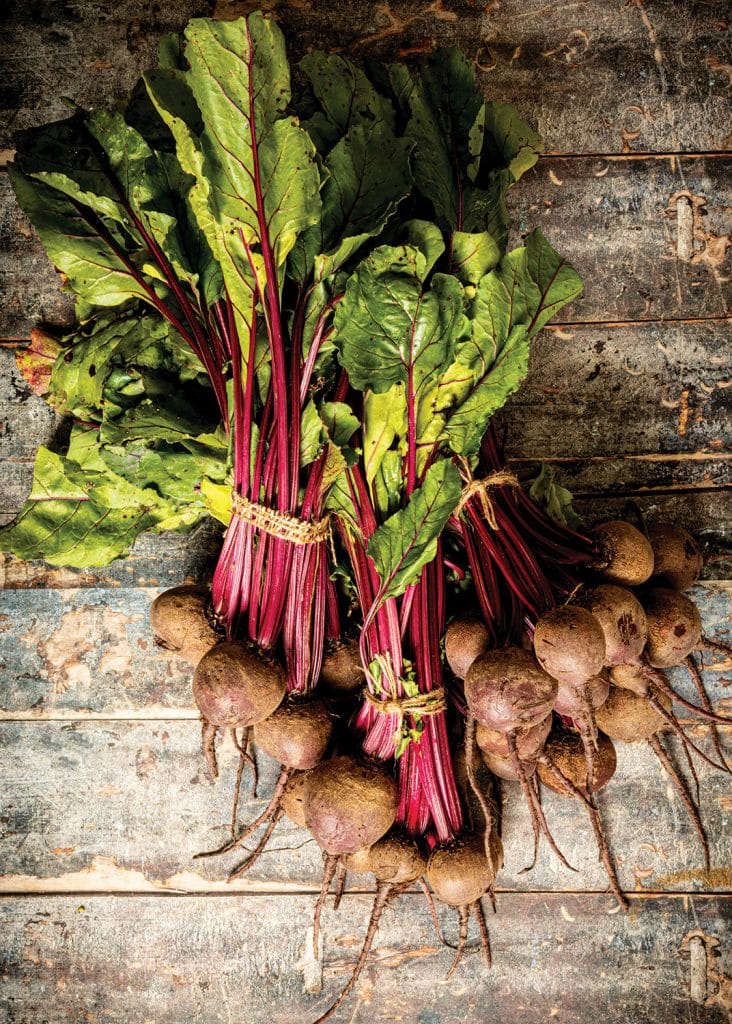
Not me. Come April, I get so overexcited I sow the whole seed packet all at once. This year, germination was virtually 100 percent, so now I have kilos and kilos of beetroot to use up. A proper glut. I pickle, make soup, shred it into slaws, roast it for dips, freeze it for winter. I’ve been known to candy it too – anything to use it up. (Candied beets are, by the way, wonderful atop cakes, but the recipe doesn’t use up much beetroot!)
Will I never learn?
Actually, I don’t want to learn. I enjoy the gluts. In fact, I relish them. And if there’s a crop I don’t grow, like plums, then I will seek them out in peak season from growers who do have a glut, meaning I can still busy my days with jams, chutneys and crumbles for the freezer.
I would encourage everyone to embrace these seasonal gluts. Why? Well, for a start, gluts are the mother of invention. Faced with a cucumber plant producing two or three cucumbers a day, you’ll be amazed how quickly you explore ideas beyond a cucumber sandwich. Without a glut, I’d never have discovered cucumber and gin sorbet. Gluts encourage creative cooking.
Secondly, the flavour of fruit and veg in peak season is so much more intense than when it’s been coaxed into ripeness in a heated greenhouse or shipped miles to your door. I thought a broad bean was just a broad bean until I tried them young, podded and raw straight from the plant, their sweet butteriness a different beast from the bitter, mealy bullets that languish in supermarket crates for days. These peak season sweeties are made for serving as a salad with goat’s cheese and sorrel dressing.
Non-growers too can experience the vibrancy of just-picked vegetables thanks to Borough Market traders like Steven Brown whose regenerative farm in Essex, 13 Acre Orchard, puts freshness first. “This approach reflects the deeper values behind shopping at Borough Market rather than at a supermarket,” he says. “Freshness is at the heart of what we offer. The produce you find on our stall is often harvested just a day or two before being sold.”
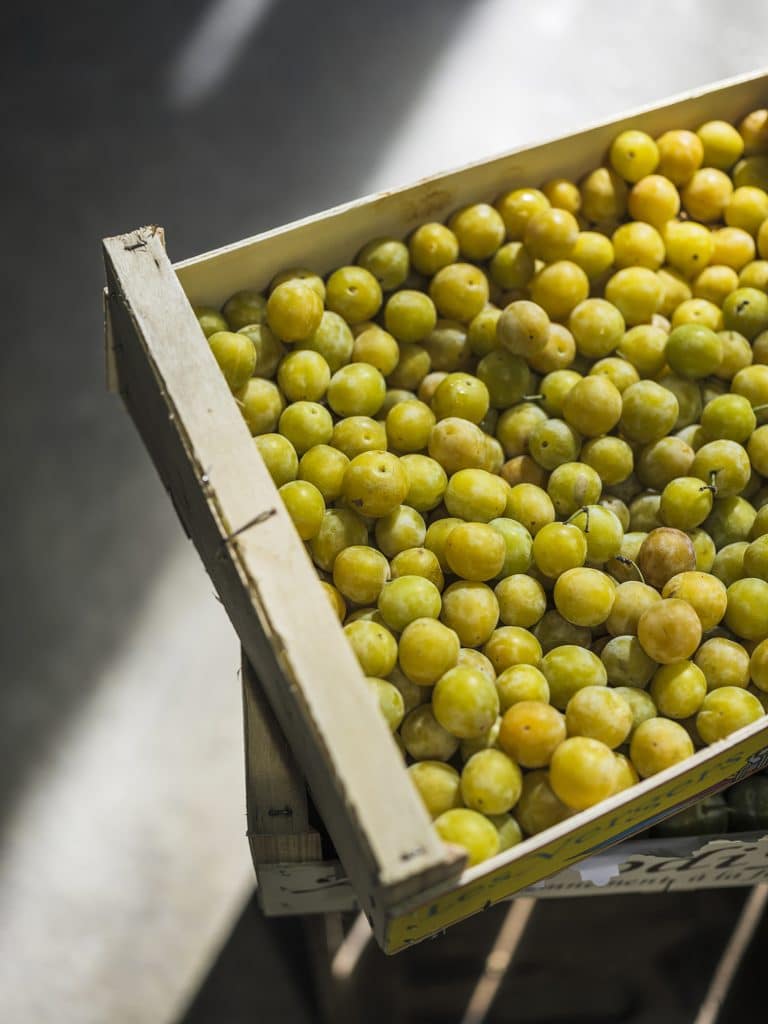
And how often in life is the better-quality option also the cheaper one? As well as being at their most flavourful, vegetables in peak season are also at their most abundant, and so often at their cheapest. This, for me, is the time to gather great bucketsful of produce to preserve and store for leaner times. It’s a frugal, satisfying and creative way to enjoy nature’s bounty all year round.
At 13 Acre Orchard, they do this on a grand scale: “During times of glut, or when fruit and vegetables don’t meet our visual grading standards, we repurpose them into preserves, jams and other long-lasting products. Apples and pears that aren’t suitable for retail are pressed into fresh juice, making sure their flavour still reaches our customers in another form.” Admittedly, a home fruit press may be an over-investment even for me, but I do take Steven’s point. And you don’t need a whole lot of kit to preserve the bounty.
As I write in my new book, Rough Patch, the most important thing about embracing seasonal gluts is that it reconnects us with nature. Our meals become tied to the land, to the weather and to the growers who produce our food. It’s a chance to celebrate and learn about the seasonal changes in a way that supermarket shopping, with its focus on shelf life and uniformity, cannot offer. “You’ll find lesser-known, heritage, and wild varieties throughout the year – products the big shops won’t stock because they value consistency over character,” says Steven.
Steven also sees embracing gluts as an act of hope, a commitment to a more diverse food system. “Shopping at Borough is about connection,” he explains. “This shared curiosity and knowledge creates an environment of inspiration and innovation. From growing and preparing to cooking and tasting, we’re all part of something bigger. Together, we’re helping shape a more abundant, creative, and seasonal future for food.”
Who would have thought that embracing a glut of courgettes could be such a manifesto for a more sustainable, joyful future?

Five techniques for making the most of gluts
Freezing
It may shatter the romantic notion you have of preserving as an ancient, rural tradition, but the freezer is your friend. Soft fruit can be halved, stoned if necessary, frozen on trays so it doesn’t clump together, then bagged up for use in smoothies, compotes or jams. Vegetables like runner beans can be cooked until just tender, plunged into cold water to prevent overcooking, patted dry and frozen for curries, stir fries and soups. Tomatoes, by the way, are glorious frozen whole then shaved, still frozen, over eggs on toast.
Pureeing
Many vegetables (cauliflower, celeriac, carrots and beetroot, for example) can be finely sliced, sauteed in butter until soft then whizzed into a velvety puree. From here they can be served as an alternative to mashed potato, made into soups by adding stock or milk, stirred through blitzed butterbeans for dip, or made into gnocchi like my cauliflower gnocchi with sage butter and hazelnut, all of which can be frozen for the ultimate ready meal stash.
Batch cooking
You might be thinking about getting a bigger freezer by now, but if you have room, processing the gluts as they arrive is a gift to your future self. No household can eat corn on the cob every day for a month (believe me, I have tried), but a big batch of chilli cornbread will use up to eight cobs and freeze marvellously. So too, savoury scones. Try these cauliflower and cheese scones, which also work well with courgettes or beetroot in place of the cauliflower. Come February, being able whip out of the freezer a beetroot soup and a courgette scone for dunking is a deep satisfaction only glut-lovers understand.
Pickling
It’s easy to imagine that making pickles and chutneys involves steamy kitchen windows, sticky worktops and endless sterilising. More production line than cooking. And yes, that’s certainly an option. But a quick pickle will often suffice in managing a smaller glut and the result is just a tasty. A quick pickle is simply equal amounts of vinegar and sugar dissolved together over a gentle heat and left to cool. Finely chopped or sliced raw vegetable can be added to the cooled liquor, then stored for a couple of weeks in the fridge. Try cucumbers (seedy middles removed), beetroot, cherry tomatoes (best left whole), ribbons of carrots, but also pears, cherries and blackberries. All will take a cheese sandwich to another level.
Jamming
As a guide, any mixture of fruit and sugar in equal quantities can be bubbled to 104C and poured into sterilised jars for storage. The fruit needs to be cooked before the sugar is added (so plums, for example, need simmering until the skins are soft) and if the fruit is low in the jam-setting compound pectin (strawberries, figs, blackberries) then a squeeze of lemon or the addition of another high-pectin fruit (apples, redcurrants, unripe plums) will help it set. Be bold with your flavours. Add rosemary to plum jam, thyme to apple and blackberry. And experiment with your ‘fruit’ – I once dealt with a marrow glut by turning it into ginger-laced jam and no one batted an eyelid at the breakfast table!
Rough Patch by Kathy Slack (Little, Brown) is available now
A taste of home
Street food traders on how dishes that reflect their roots have found a home away from home at Borough Market


“I FELT THAT PEOPLE IN LONDON WERE MISSING OUT ON THE STREET FOOD I GREW UP WITH BACK HOME”
Words: Shahnaz Ahsan
It was a desire to cook the familiar food of home that motivated Gaurav Gautam, chef and co-founder of Indian street food stand Horn OK Please, to start his business. Gaurav moved to the UK from India in 2001 to pursue a degree in advertising. But his gastronomic experience was a far cry from what he was used to in his home state of Gujarat, where street food is almost as integral a part of student life as studying.
Gaurav’s formative years had been spent feasting on popular street snacks of bhel puri, pani puri and samosa chaat. In contrast, the university town he moved to in Cornwall was home to one single ‘Indian’ restaurant, run by a Nepalese family. Even after relocating to London the following year, Gaurav was disappointed by the Indian cuisine on offer. “There were curry houses in northwest London,” he says, “but I felt that people were missing out on the street food I grew up with back home.” Driven by necessity, Gaurav started teaching himself to cook through trial and error, experimenting with the fermentation of different dosa batters. Eventually, his hobby ended up becoming his career.
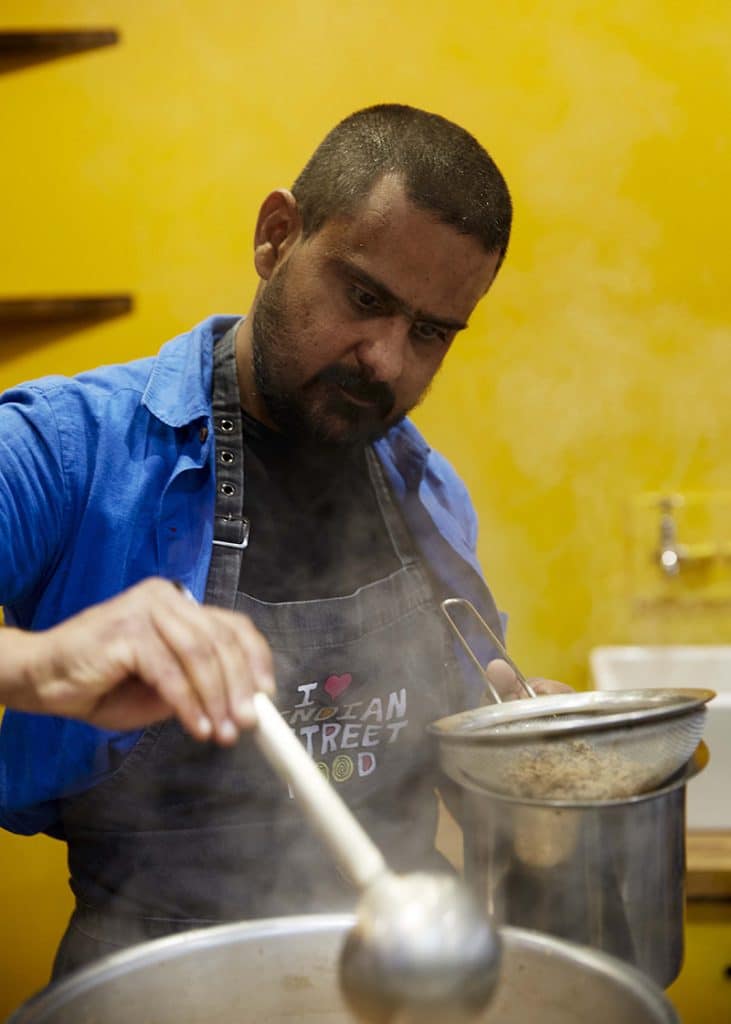
Elizabeth Haigh, chef-owner of Mei Mei, Borough’s Singaporean street food stand, was similarly inspired by a desire to recreate the food of her childhood. Raised by a Singaporean mother and British father, Elizabeth spent her early years – and almost every summer thereafter – in Singapore. “It was a privilege to experience both cultures,” she reflects. Like Gaurav, she had been encouraged by her parents to pursue an academic path. She was four years into her architecture degree before a friend “drunkenly dared” her to enter MasterChef in 2011. Despite not going on to win, her successes on the programme gave her the encouragement she needed to switch paths.
“I pulled out of university and started at the very bottom of training to be a chef,” Elizabeth explains. She trained in classical French cooking for three years before going on to work at a Michelin-starred restaurant in Bray. In 2017, she won a Michelin star of her own at Pidgin in Hackney. But despite these early successes, she walked away from the high-end restaurant world to set up Mei Mei – a ‘kopitiam’, or coffee shop, serving street food dishes such as Hainanese chicken rice, char siu pork and nasi lemak. “People thought I was crazy to go from Michelin to street food,” Elizabeth laughs. “But there’s no difference to me – the same care goes into all the food I cook. I dreamed of cooking the food that I love.”
The food she loves most is the Singaporean food that was served at the family table six days a week, with Sunday reserved for a British roast dinner. “My mum taught me my palate,” explains Elizabeth. “She doesn’t cook anything by measurements, it’s all by eye.” There is a term to describe this intuitive approach to cooking: ‘agak agak’. As an aunt explained to Elizabeth, “it’s like your ancestors telling you how much of each ingredient to use.”
Gaurav similarly credits his parents, both of whom were talented cooks, although they were initially perplexed by his change in career. “My mum was a teacher and my dad a space scientist. Being from an Indian background, working in food was the last thing they wanted me to do!” But they soon got on board when they saw how satisfied and successful Gaurav was in his new field. “They’re proud. They know I’ve found my happy place.”
For Joel Ferrer, owner of Venezuelan eatery La Pepiá, family support is also of fundamental importance – so much so, that his company logo is a portrait of his grandmother’s smiling face. “I was raised by women, they taught me to cook,” Joel explains. His early years were spent in Caracas, Venezuela. When he moved to London almost a decade ago, he came with the idea of producing and selling his grandmother’s salsa. And, to go with it, arepas. These corn savoury doughnuts – a quintessential Venezuelan snack – have proved remarkably popular with visitors to Borough Market.
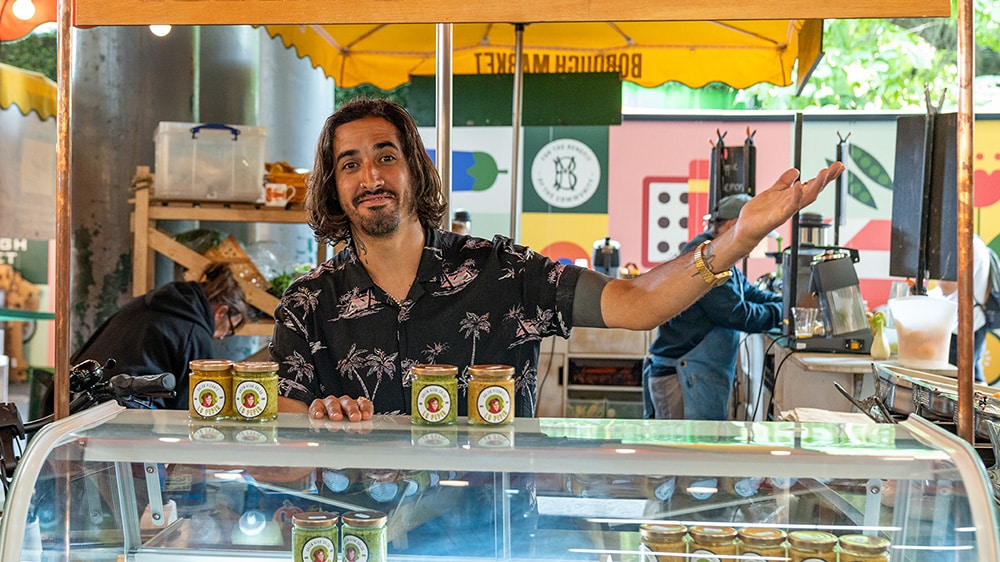
As well as bringing traditional arepas to a new audience, Joel has also embraced the opportunity to innovate. Sourcing many of his ingredients from the Market, Joel has come up with twists on the usual arepa fillings: from basil and tomato to olive oil and rosemary, even experimenting with sweet fillings such as guava jam. And of course, his signature dish: the pretty rainbow arepa – coloured with beetroot and spinach – which has become a bestseller. With a focus on dairy and gluten-free offerings, it is important to Joel that La Pepiá is inclusive and sustainable in every possible way. And like Gaurav and Elizabeth, it’s important to him that food creates the opportunity for connection.
“There are not many Venezuelans in London,” Joel says, “but they find us. And we have Colombians who have their own arepas but still come to us.” Even they have embraced his new European-inflected inventions. “It’s not what people are used to but once they get the concept they love it.” In fact, diaspora Venezuelans across Europe have been getting in touch with Joel, inspired to set up their own arepas eateries.
Gaurav shares Joel’s pride at the response of his compatriots. “I wanted to cook for other people, not just for me,” he says. “When Indians stop by the stall, even if they don’t buy anything, the look in their eyes as they recognise these familiar foods – it makes me really happy. It takes them back to their memories. It’s a reminder of home.”
The Jackfruit Chronicles: Memories and Recipes from a British-Bangladeshi Kitchen by Shahnaz Ahsan (HarperNorth) is available now
Cynthia’s pepper pork neck
Cynthia Shanmugalingam, chef-owner of Rambutan, on her favourite fire-cooked dish
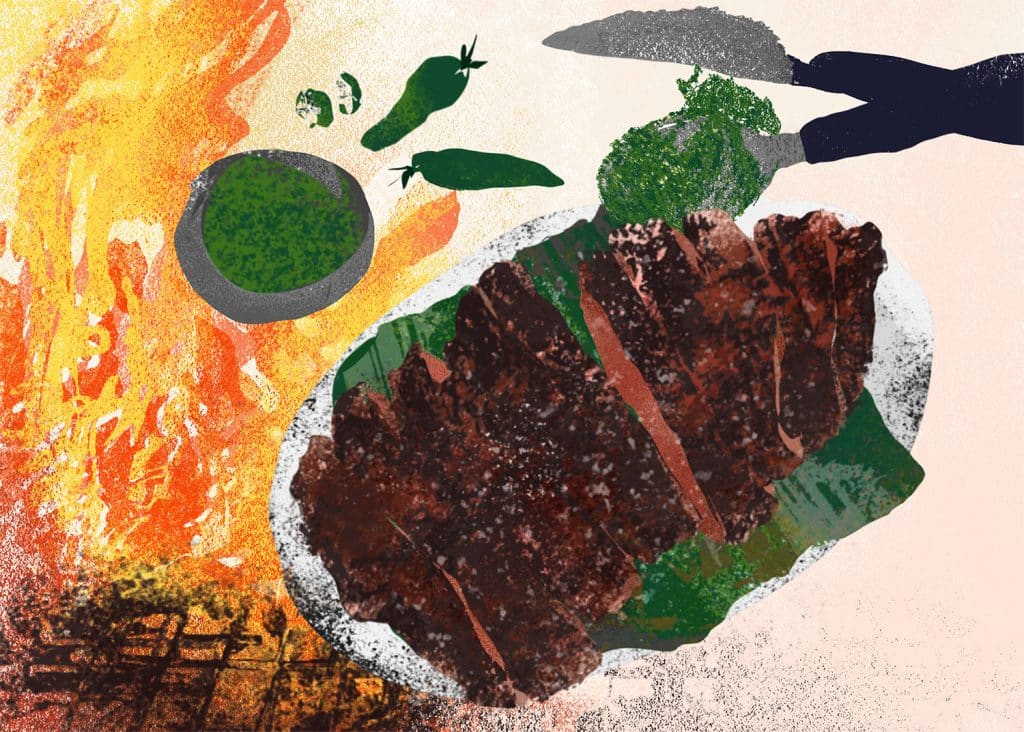

“COOKING OVER FIRE IS A WHOLE PROCESS. IT’S NOT LIKE SWITCHING ON AN OVEN – AND THAT’S WHAT MAKES IT SO EXCITING”
Interview: Mark Riddaway / Illustration: Megan St Clair / Portrait: Carol Sachs
As barbecue season kicks into gear, some of Borough Market’s experts have been sharing the secrets of their favourite fire-cooked dishes. Cynthia Shanmugalingam is the chef-owner of the Rambutan restaurant, where one of the most popular dishes cooked over coals is pork neck in a bright, peppery marinade.
Born and raised in England but with roots in Sri Lanka, Cynthia finds inspiration in the vibrant food culture of her ancestral home but views it through the unique lens of her British upbringing and global travels. At the heart of her Borough restaurant is a large charcoal grill. “There’s something magical about walking into a space where a fire is going,” she says, “and it’s fun for the chefs, who love learning how to deal with fire.”

The dish
Pork neck is a lovely, forgiving cut of meat to cook over charcoal. We marinate it in lots of Sri Lankan black pepper, which is the real star of the show – super-fragrant, almost floral. There’s also some cumin, some ginger and garlic and a little bit of kithul jaggery syrup to give it a touch of sweetness (although you could use maple syrup instead). We grill the pork then serve it with a pickled chilli sambal, which is basically green chillies, vinegar and sugar: hot and sharp, to cut through the pork.
The inspiration
Sri Lankans don’t actually have a big tradition of grilling. Fire cooking is fundamental to Sri Lankan cuisine, but they tend to build a fire and then cook curries in clay pots over the flames. Rambutan is not a super-traditional Sri Lankan restaurant, though. I was born in England, grew up here and travelled around a lot, all over the world, so this place is a mix of all my influences. I wanted to have a charcoal grill front and centre, but grilling Sri Lankan food requires a little bit of adaptation. We might, for example, take a traditional curry recipe and then recreate the flavours through a marinade or a dry rub. This pork dish was invented by one of our young chefs, Jack, who was inspired by black pepper beef, a classic Sri Lankan curry from the west of the country.
The ingredients
The pork in Sri Lanka is fantastic quality – there are all these small, dense pigs that run around all the time and are just so flavourful. Over here, we’re looking for that same depth of flavour, and that can only come from animals that have got space to roam and are fed and reared amazingly well. We use Middle White pork from Swaledale in Yorkshire. The taste of the meat is so deep, it’s almost gamey. The quality of the black pepper is also essential. It’s known as Malabar pepper, produced down the Malabar coast of southern India and into Sri Lanka. It’s so good that wars have been fought over it! ‘Black gold’, they used to call it. It’s really floral. Bright and fragrant. Almost citrussy.
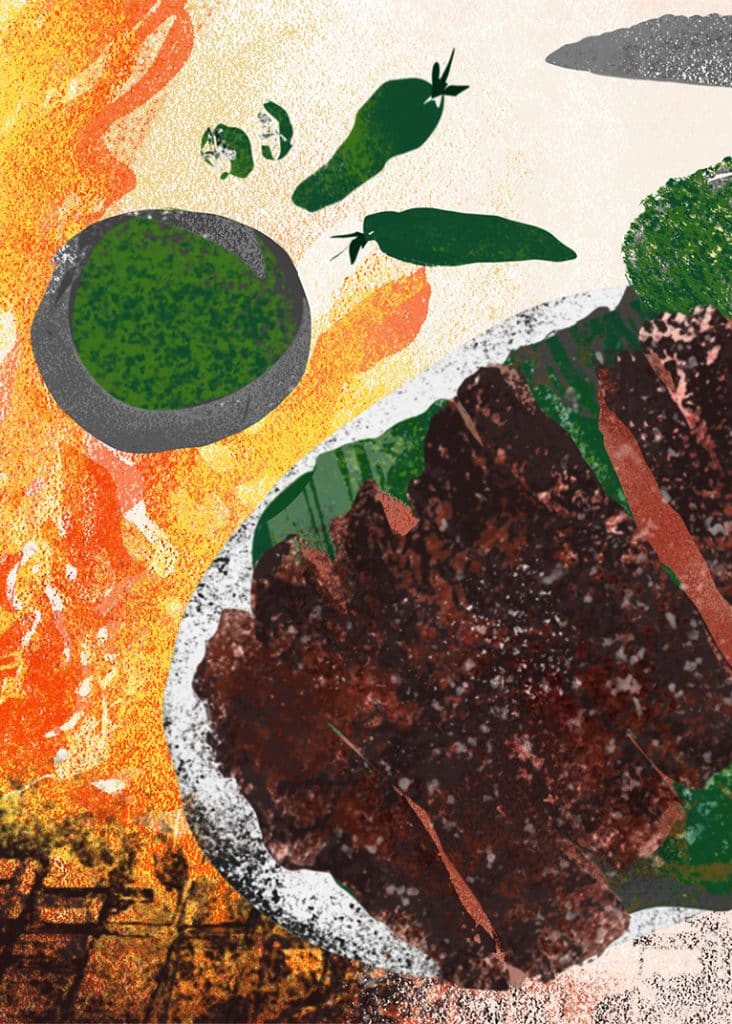
The method
We grill the pork over the hottest part of the charcoal, so it doesn’t take long – a few minutes each side. We cook it to an internal temperature of 45C, then let it rest for about five minutes. It’s at its best when it’s still slightly blush inside, as long as the guests are okay with that.
The fuel
We use pure lumpwood charcoal with no chemicals. It gets good and hot and retains its heat very well. I feel that if there’s anything chemical in the charcoal, you can really taste it, so we only use the best quality charcoal we can get our hands on.
The appeal
Fire is magical, fire is mesmerising. Cooking over fire is a whole process – it’s not like switching on an oven – and I think that’s partly what makes it so exciting. In Sri Lanka, most cooking is done over wood, so you have to build the fire first – the big sticks, the little ones, the paper – and that makes it so involving. It also imparts the amazing aromas and flavours of the smoke. In Sri Lanka, try as the government might to bring in gas or electricity, the women – and it is largely women who do the cooking – still want to cook over wood. They just feel there’s nothing quite like those incredible smoky flavours.
The pro tip
People should grill more vegetables! We put lots of veg on our grill – the sugars caramelise, and they take on such an amazing quality. Aubergine, corn, broccoli, anything. Often, if you go to someone’s house for a barbecue, it’ll be the meat that gets the focus, but vegetables can be just as delicious.
David’s charred squid skewer
David Carter, the restaurateur behind OMA and AGORA, on his favourite fire-cooked dish
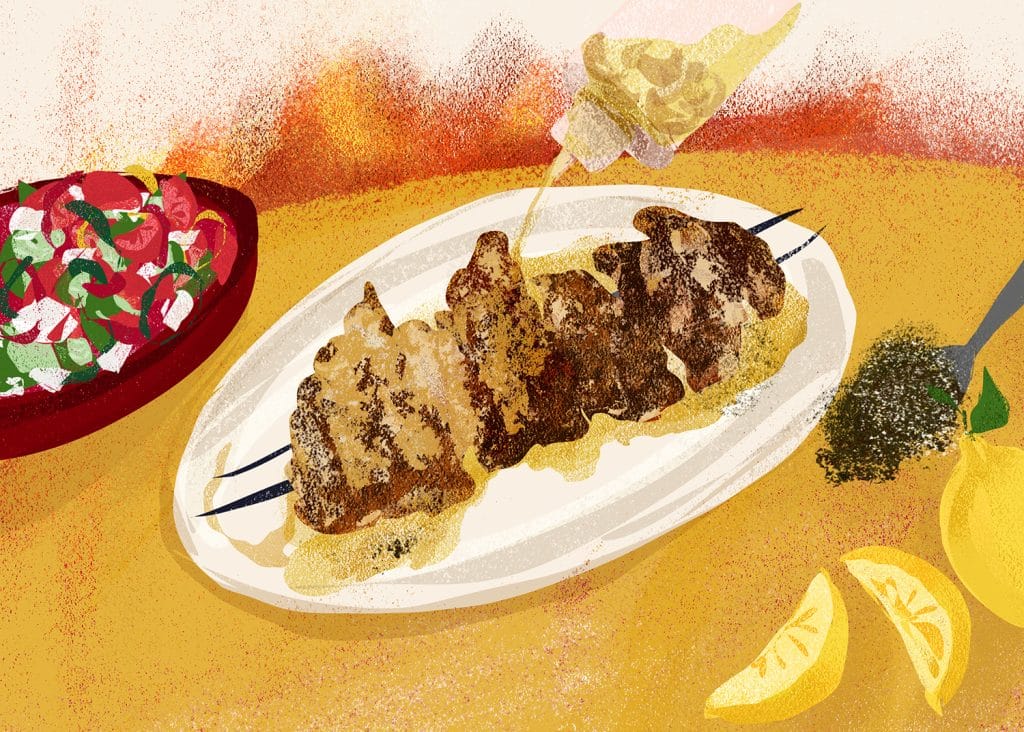

“THERE’S SOMETHING PRIMAL AND COMFORTING ABOUT FIRE. I WOULD RATHER LIGHT A FIRE THAN PUT A RADIATOR ON”
Interview: Mark Riddaway / Illustration: Megan St Clair / Portrait: Anton Rodriguez
As barbecue season kicks into gear, some of Borough Market’s experts have been sharing the secrets of their favourite fire-cooked dishes. David Carter is the restaurateur behind Borough’s OMA and AGORA. At OMA, one of the many skillfully executed, Greek-inspired small plates on offer is a squid skewer dressed in a simple olive oil marinade.
In common with his other London restaurants, OMA and AGORA both have a significant fire-cooking slant to their menus. It’s only natural. David was born and raised in Barbados, where cooking over wood or charcoal is central to the island’s cuisine, social scene, family life – everything, really. “Every day is 27, 28 degrees, so it’s just part of the culture,” he says. “What could be nicer?”

The dish
This is a very simple dish. We cut off the head and wings of the squid and just use the body. We score it quite heavily, which means that when we grill it we get this amazing texture – squid can be quite chewy if you’re not careful. We brush it with olive oil that we’ve infused with confit garlic, za’atar and lemon juice. The confit garlic is almost a bit pasty in texture, in a good way, and that really adds to the feel of the dish. We then grill it over charcoal and serve it straight away.
The inspiration
This dish was inspired by a restaurant in Athens called Travolta. OMA and AGORA are both rooted in Greece, but in a broad way. Not all the flavours are Greek – like the za’atar we use here. We did a lot of travelling when we were working on the concept, including to Tel Aviv, and that’s where the idea of adding za’atar came from. We can get squid through most of the year, but I think this really lends itself to being a summer dish – it has that lightness. I’d maybe have it with something tomato-based, with high acidity. A Greek salad, maybe. Light, vibrant dishes and zippy wines.
The ingredients
With so few ingredients, there’s nowhere to hide. Everything has to be good. The squid comes from the southwest of the country. It’s an amazing product. Most of the fish and seafood we use comes from Cornwall, from Brixham market. It’s caught and landed one day, it comes to us overnight, and the next day it’s in our kitchen. One of the great things about being such a busy restaurant is that whatever comes in goes pretty fast – it arrives and we cook it. The olive oil comes from a regenerative farm in Crete, run by two brothers. They’re actually British – one of them married a local girl. They moved out there to Zakros and started this incredible olive oil project. We’re now using it across all our sites.
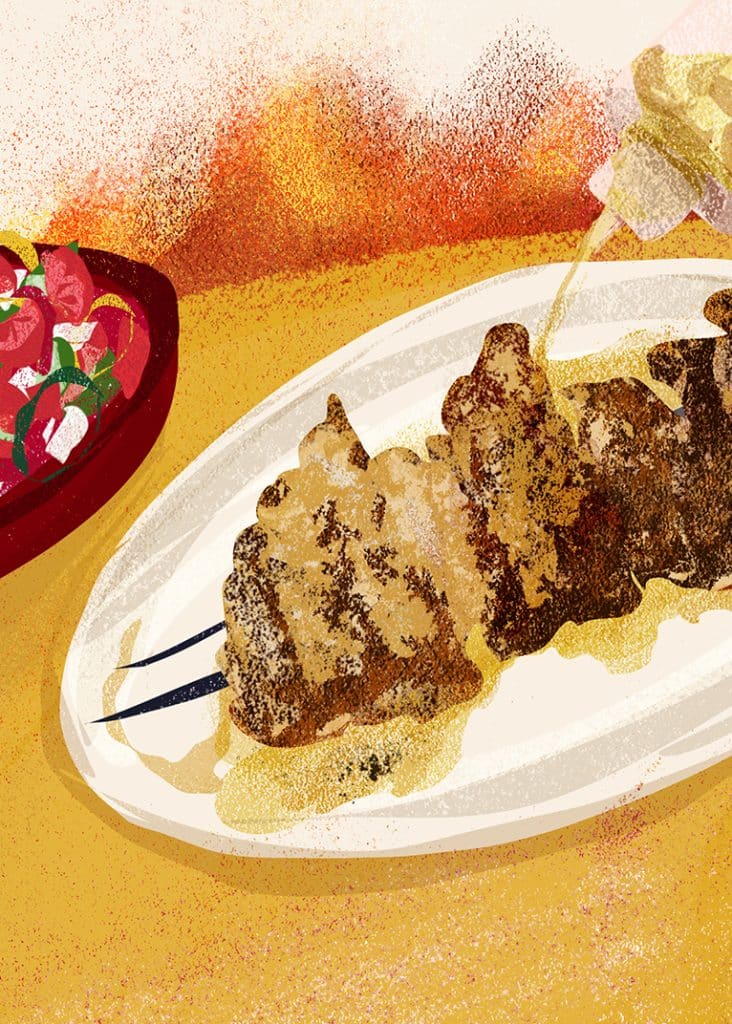
The method
The trick is to have the grill hot, but not too hot. You don’t want to blacken the squid; you want it to be a deep dark brown. It takes about 6 minutes, so not long. With squid, or with almost any fish, you want to pull it off the grill when it’s a little under. Because of the residual heat, it’s still cooking when it gets to the table. If you overcook it, it becomes chewy and rubbery, which is horrible.
The fuel
We use very pure charcoal. With grilling, it’s about the fuel, but it’s also about the interplay with the fat – that’s what creates the flavour. When the oil from the squid drips onto the coals it creates smoke, which then permeates the food above. That’s what grilling is all about – when fat renders onto hot coals, and the coals get a bit angry, and all that flavour is released into the air. You can’t get those flavours on a stove.
The appeal
I grew up in Barbados. I grew up outdoors. There, every day is a barbecue – it’s just part of the culture, so cooking over fire is what I’m most comfortable with, for sure. There are so many variables, with the fuel and the heat, and that’s what makes it interesting. It’s such a versatile and simple way of cooking – all you need is some charcoal on a beach and you have a barbecue. There’s something primitive and primal about it, something comforting, warming. I’ve got a fireplace at home, and when it’s freezing outside I would rather light a fire than put a radiator on.
The pro tip
Have fun with it. Some people take barbecuing far too seriously. It should be social and fun, and if you don’t cook something perfectly, who cares? Also, be patient. When you light it, let it burn out properly. When it’s flaming, that doesn’t mean it’s necessarily lit – with bad charcoal, it’s the chemicals that are burning, and if you cook too early your food will just taste of lighter fuel. Let it come to temperature, let it do its thing. Wait until it’s glowing red or white, and don’t be frightened to move it around. If it’s too hot, disperse it; if it’s not hot enough, bring it together. Play with it. The fire is your friend!
Nick’s jambalaya
Nick Willoughby, founder of The Black Pig, on his favourite fire-cooked dish
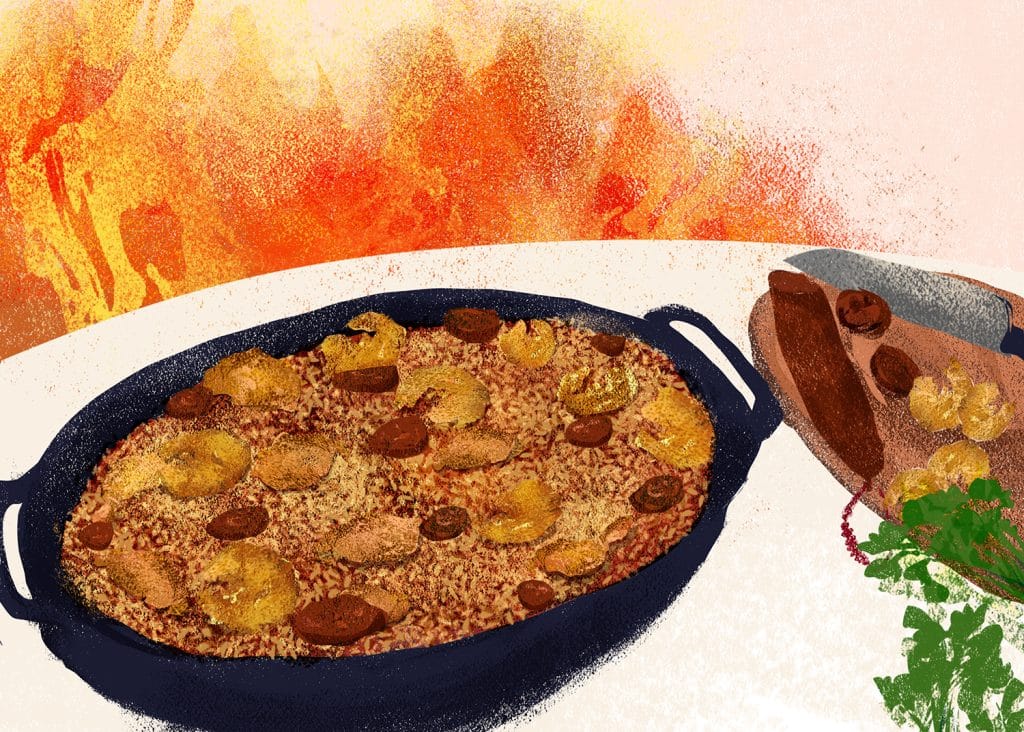

“YOU GET LOVELY CARAMELISATION IN THE PAN, BUT WITH ALL THAT EXTRA FLAVOUR THAT YOU COULD NEVER GET ON A HOB”
Interview: Mark Riddaway / Illustration: Megan St Clair
As barbecue season kicks into gear, some of Borough Market’s experts have been sharing the secrets of their favourite fire-cooked dishes. Nick Willoughby is the founder of The Black Pig, which sells its world-famous sandwiches in the Borough Market Kitchen. For these, slow-roasted pork is finished in the heat and smoke of a kamado barbecue before being piled generously into pillowy toasted ciabattas.
Nick, a fire-cooking obsessive, talked to us about the dish he most enjoys creating in his own back garden. “I’m passionate about Cajun and Creole cooking,” he says, “and my favourite dish to cook on the barbecue is a jambalaya.”

The dish
I sear all the main elements on the grill first – the andouille sausage (the American version, not the classic French one), the chicken, the shrimp – not to cook them all the way through, but to give them some real colour and flavour from the coals. In a paella pan on the barbecue, I cook down the Cajun ‘holy trinity’ of celery, green pepper and onion with some tomato paste, Cajun seasoning and Old Bay spice blend, then throw in long grain rice and chicken stock. Once that’s bubbling away, I add in the seared meat and seafood. For this to work, you need a barbecue with a lid that can close. Chuck in a few woodchips to create a bit more smoke, then leave it to cook through slowly. It smells amazing, tastes amazing, and you get these lovely gnarly caramelised bits around the sides. Stick it in the middle of the table and let everyone help themselves.
The inspiration
I used to live in the United States. I was an aspiring golf pro at the time, so I did a lot of travelling. I fell in love with New Orleans – I’ve been there many, many times. I love that it’s this melting pot of people and cultures. You’ve got that French influence, but also Spanish and Caribbean. That’s reflected in the food: you’ve got these amazing recipes that use traditional French cooking techniques but are packed full of spice and flavour.
The ingredients
The quality of ingredients is essential. I like to know that my food has been produced in the right way, with care and attention, which also results in better flavour. At The Black Pig, we use free-range Blythburgh pork – when you slow-cook it, it retains its structure and flavour, whereas mass-produced pork goes to mush and tastes of almost nothing. When I’m at home, it’s the same principle. If I’m going to use prawns in my jambalaya, I want prawns that taste like they’ve come from the sea. I want chicken with real depth. Borough is where I come to do my shopping – and I’m not just saying that because I’m a trader. I love coming early in the morning at the weekend. I bring the kids down. We go to the fish stands and to Spice Mountain, which is just amazing. If I’m trying to cook something interesting, it has everything I need.
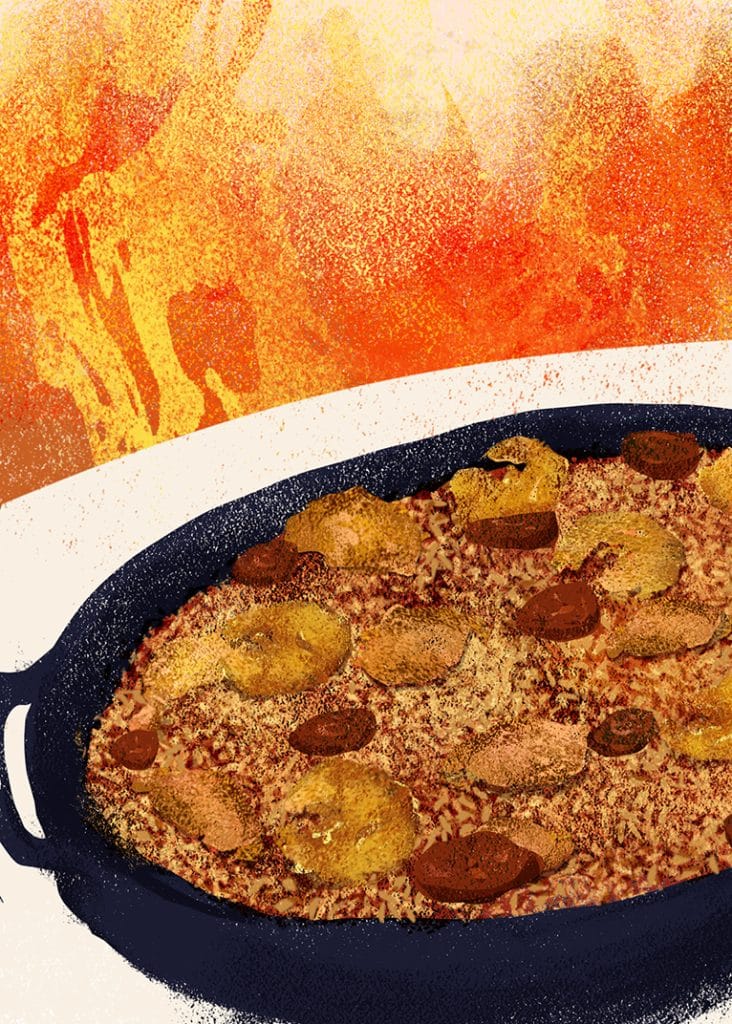
The method
People in Britain rarely use pans on a barbecue, but it’s such a great thing to do. It really struck me when I went on holiday to Carriacou, a little island off Grenada. We were at this beach barbecue where there was a guy cooking fish with a simple tomato and red pepper sauce. He had the sauce on a pan on the barbecue, and because of the smoke that was slowly seeping in, the flavour packed into it was unbelievable. You can draw so much heat from a barbecue, so you can get that lovely caramelisation in the pan, but with all that extra flavour that you could never get on a hob.
The fuel
Fuel is really important. If I’m cooking on my own and I’ve got lots of time, I love cooking with logs, but next best thing is lumpwood charcoal. It’s basically big old chunks of burnt wood, whereas the stuff you get from a petrol station is like dust in a bag. A few woodchips in with the coals can be good too. At The Black Pig we throw in some apple woodchips, and that gives our pork a blast of extra smoke when we finish it on the barbecue.
The appeal
I barbecue at home throughout the year, probably two or three times a week. I love the flavour that comes off the barbecue, and I love how involved it is. I hate baking, I can’t deal with fixed parameters, but with a barbecue you’re really connected to what you’re doing. It creates atmosphere, it draws everyone outside, it’s social. I’m not much of a person for plated dishes – I like doing food for the table for people to share, creating that environment where everyone’s sitting together, chatting. Also, I love getting my kids involved in food, and they’re instantly drawn to the barbecue, which is brilliant.
The pro tip
Control the temperature. A lot of people get their barbecue super-hot and just use it to blister sausages, but it can be so much more versatile than that. You can slow cook, you can pan cook. Just think about what it is you’re cooking and set the heat accordingly. If you’re cooking a steak indoors, you’ll get the frying pan really hot. Do the same outdoors: load up your barbecue, get it blisteringly hot and really give the steak some serious colour. But if you’re roasting a chicken in your oven, you don’t do it at 300C, so for chicken just put a few coals in and get it to about 160C.
Crunch time
Ed Smith sets out to uncover the secrets of the perfect salad
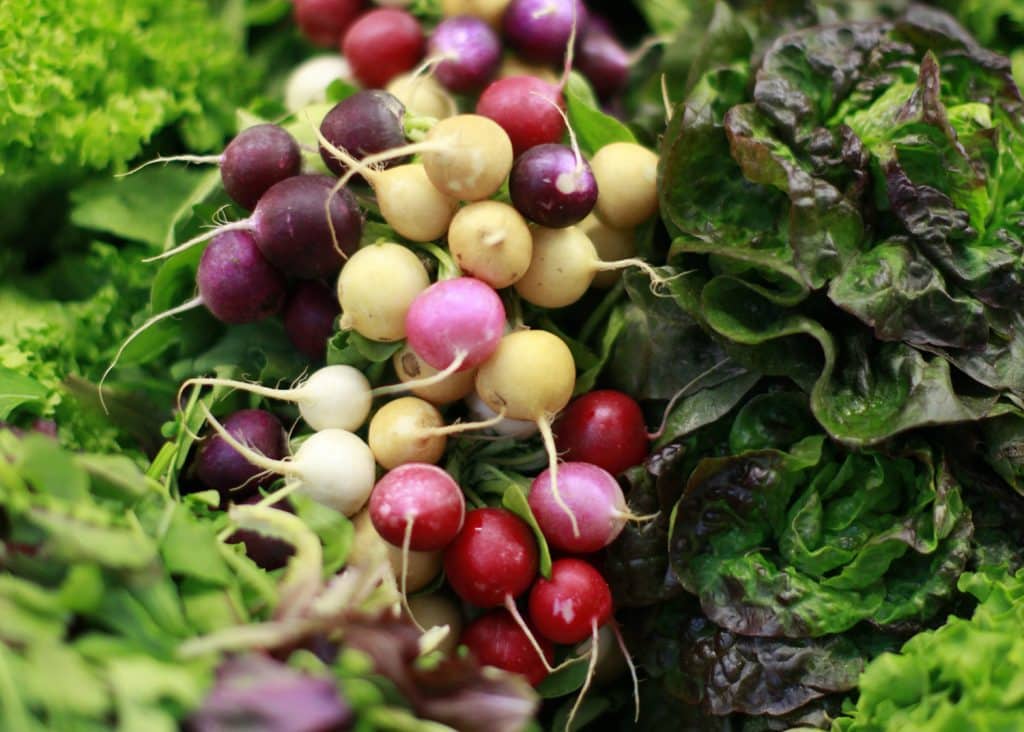

“A SALAD SHOULD BE A BALANCED MIX OF TEXTURES WITH A VARIETY OF FRAGRANT, SWEET, SHARP AND SALTY FLAVOURS”
Words: Ed Smith
Summertime means salads – the freshness, variety and style of produce prompts them, while the weather necessitates less time near a hot stove and more time eating crunchy, fragrant, and invigorating foods.
What makes a good salad, though?
To answer that, we should probably first define what a salad actually is. What links a bowl full of lettuce leaves with a platter of tomatoes, a Greek-style mix of cucumbers and feta, or some burnt corn kernels, combined with jalapeños, coriander and lime?
Alexa, define ‘salad’
Obviously, as it’s 2025, I checked with ChatGPT as to what the aggregation of human knowledge considers ‘salad’ to be. Happily, it wasn’t actually that helpful – almost as if something that’s never eaten food isn’t as discerning as a sentient being (yet)!
Distilling the points the app dredged up, though, plus dictionary definitions and (gasp) my own thoughts, might I propose something along the following lines:
A salad is:
(a) a collection of raw edible leaves; or
(b) a dish of vegetables and / or fruits, which may be raw or cooked, but are typically served cold
bound by a dressing, and often combined with a variety of other embellishments and toppings, including (but not limited to) seeds, nuts, grains, cheeses, cooked or cured meats.
Quite broad, then. But a decent place to begin.
Whether it’s leaves-based or an assembly of other things, to my mind and mouth a good salad should be a balanced mix of textures. There should be a variety of fragrant, sweet, sharp and salty flavours. And the dressing should gloss and lift the ingredients, unifying not overwhelming them.
The other – and perhaps easier – way to ensure a salad is good is to use great ingredients! Shopping at a place like Borough Market makes this part easy. In reality, you’re only restricted by the limits of your imagination, but consider these building blocks.

The leaves
As mentioned, not every salad needs to be a leafy one. But if it’s this type of salad that you’re after, think about the following:
— Look beyond iceberg lettuce and supermarket bagged salad
While iceberg lettuce is excellent as a wedge-style salad, drenched in a ranch or blue cheese dressing, we can do better. Walk around the various Borough Market grocers and you’ll find a wide variety of whole lettuces, including butterhead, romaine and frilly, multicoloured heads of lettuce that few know the name of. Buy a couple of different lettuces and keep them refrigerated in their brown paper bags. They’ll last longer than those gassed bags from the supermarket, which somehow wilt and pong as soon as they’ve been opened.
— Seek vibrant flavours, not just carriers of dressing
More specifically, treat your mix of leaves as vital and variable ingredients, each with its own defined flavours. It’s good to have a neutral base, but at the Market you’ll also find the punchiest rocket, watercress, radicchio and other bitter chicories. If you’re lucky and it’s the right time of year, you might chance upon sorrel and mustard leaves, their distinctive citrus and, err, mustardy qualities capable of lifting a salad like no others. 13 Acre Orchard often has really vibrant leaves in its refrigerated section. Because they are flavoursome, a little goes a long way.
— Use fresh herbs
If those things don’t take your fancy, or you’ve not spotted anything beyond the normal leaves, grab some fresh herbs and treat them like salad leaves. One of the advantages of buying herbs from the Market instead of a supermarket is that they come in huge bunches and represent great value. Using things like mint, parsley and dill with abandon will make your salad sing. Grocers like Hickson & Daughter and Turnips are great for these.
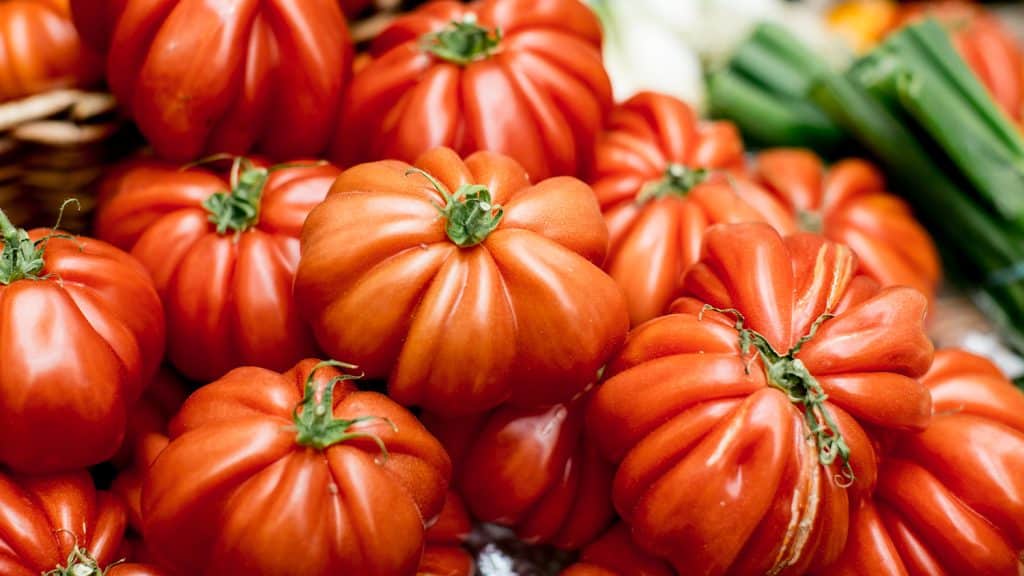
The other vegetables and fruits
— Understand that everything salads (verb)
Per the broad definition at the top, most vegetables (and quite few fruits) can be turned into a salad. There are the obvious and traditional things, such as cucumbers, tomatoes, peppers and radishes. But think slightly towards the edge of the box for things such as corn on the cob, asparagus, fresh peas and green beans, which you may (or may not) prefer to blanch and shock. Harder items like celery, courgettes, fennel and kohlrabi, and fruits like apples, pears and persimmons, are best sliced thinly with a mandolin. Root vegetables such as potatoes and squash can be boiled or roasted, then cooled. Really the best thing to do is stand in the middle of one of the greengrocers, look at what’s in abundance, and take it from there.
— But keep it focused
That said, don’t just throw everything in. It’s good to think either in ones (a straight up tomato or roast pepper or beetroot salad, punctuated by one or two embellishments – see below) or in threes, with each of the core salad ingredients offering a different flavour – perhaps one is relatively neutral, another feisty, and the other sweet. Kohlrabi, radish and apple, for example. Or cucumber, red pepper and tomato. Or avocado, green pepper and sweetcorn.
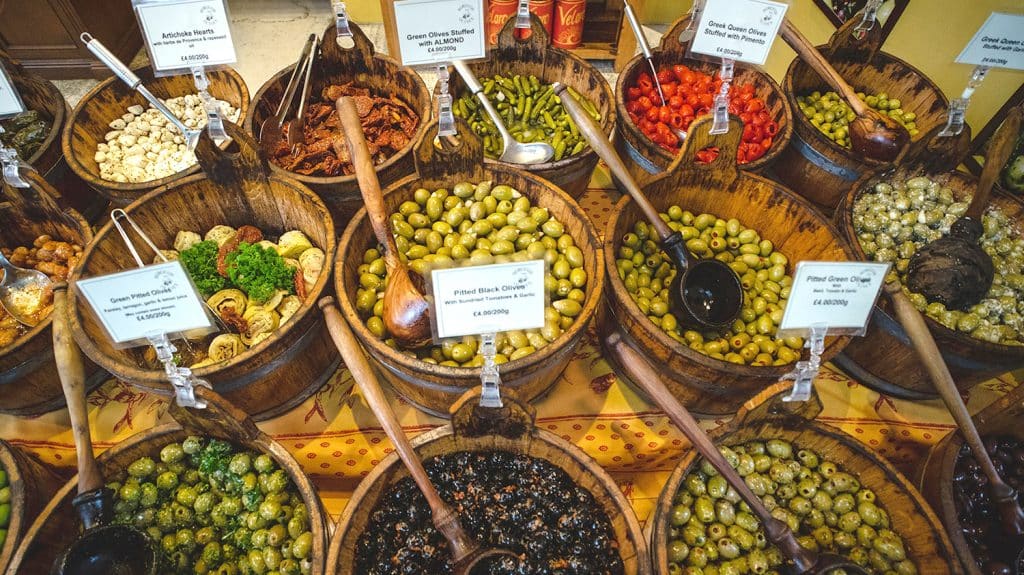
The interesting bits
This is where doing your salad shopping at Borough Market becomes really smart. Where artisans have already imparted layers of flavour into particular ingredients, this immediately adds their quality to whatever you’re preparing. You can and should explore and let your creativity go wild, but some of my favourite salad embellishments include:
— Jarred and deli-style bits
Not every salad, but quite a lot of them (particularly non-leafy varieties), benefits from the contents of jars or deli tubs. Marinated olives, capers, salted anchovies, sundried tomatoes, pickled peppers, artichoke hearts in oil, and other antipasti are all ideal. There are loads of places to pick up really good versions, including Oliveology, Borough Olives, De Calabria, Gastronomica, Brindisa and Northfield Farm.
— Cured meats or sharp cheeses
There’s no better place in London to shop for quality, artisan cheeses and cured meats. And using those things in a salad is an excellent way of making your purchase go a long way – little nuggets of sharp, punchy flavour and pleasing textures, interspersed among leaves or crunchy vegetables. There are over 25 dairy and cured meat traders at The Market – take your pick!
— Something crunchy
Really good nuts, such as hazelnut, walnuts, cobnuts, pistachios from the likes of Food & Forest, Oliveology and Brindisa, will provide a notable and moreish savoury crunch. Alternatively cut or blitz your two-day old end of sourdough, focaccia or rye bread, slick with olive oil and fry or bake into croutons.
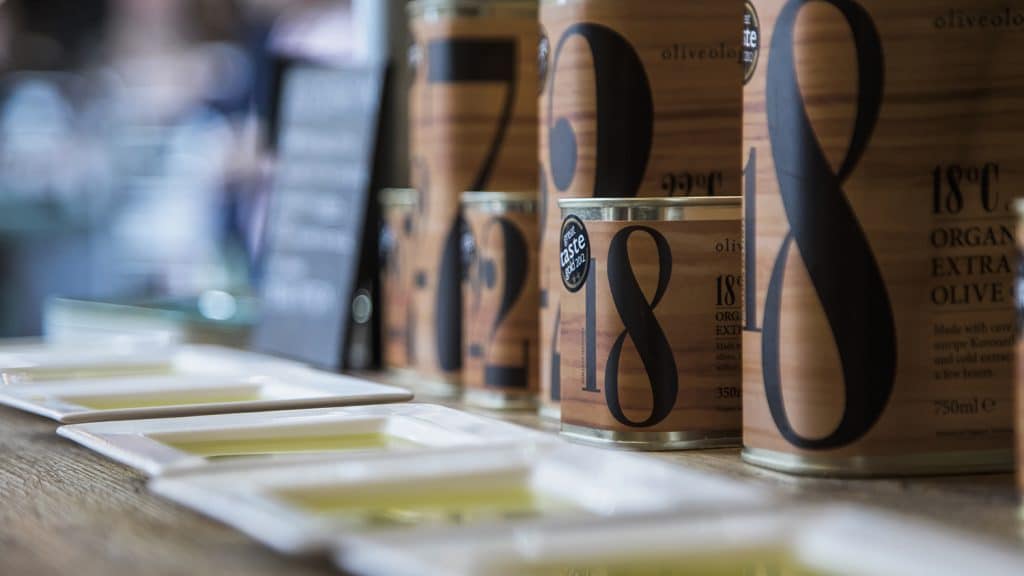
The dressing
Return to my definition at the top and you’ll note that the crucial element in a salad is the dressing: it is this that binds the various elements, and in so doing turns a collection of unrelated ingredients into a salad.
A dressing might simply be a squeeze of lemon or splash of vinegar, it could be one of those acidic items whisked into an emulsion with olive oil, or it could involve multiple other flavourings – mustard, maple, honey, herbs, yoghurt or buttermilk. Again, the world is your oyster. And again, if you’re shopping for dressing ingredients at Borough Market, then you’re off to a good start. There are too many options and dressing styles to detail here, but there are a few points worth noting.
— Olive oil is not neutral
Some olive oild are grassy, some are peppery, some are really, really feisty. It’s ideal to have a few options in your cupboard. Try before you buy at traders such as The Olive Oil Co.
— Quality vinegars are game-changing
There are masses of fantastic balsamic vinegars to try at the Market. But I also recommend adding a quality sherry vinegar and moscatel vinegar to your arsenal. And spend time at Fitz Fine Foods, who have a variety of really interesting fruit-infused vinegars and flavoursome mustards.
— Honey goes a long way
I like dressings that are not just sharp, but also a little bit sweet. A good honey is one of the nicest ways to round off a dressing. Once again, there’s loads to choose from at Borough Market, including at From Field and Flower.
That’s it. Once you look beyond the meagre and dispiriting bags of supermarket salad and instead build bowls and platters of Market-bought ingredients, you’ll never look back.

